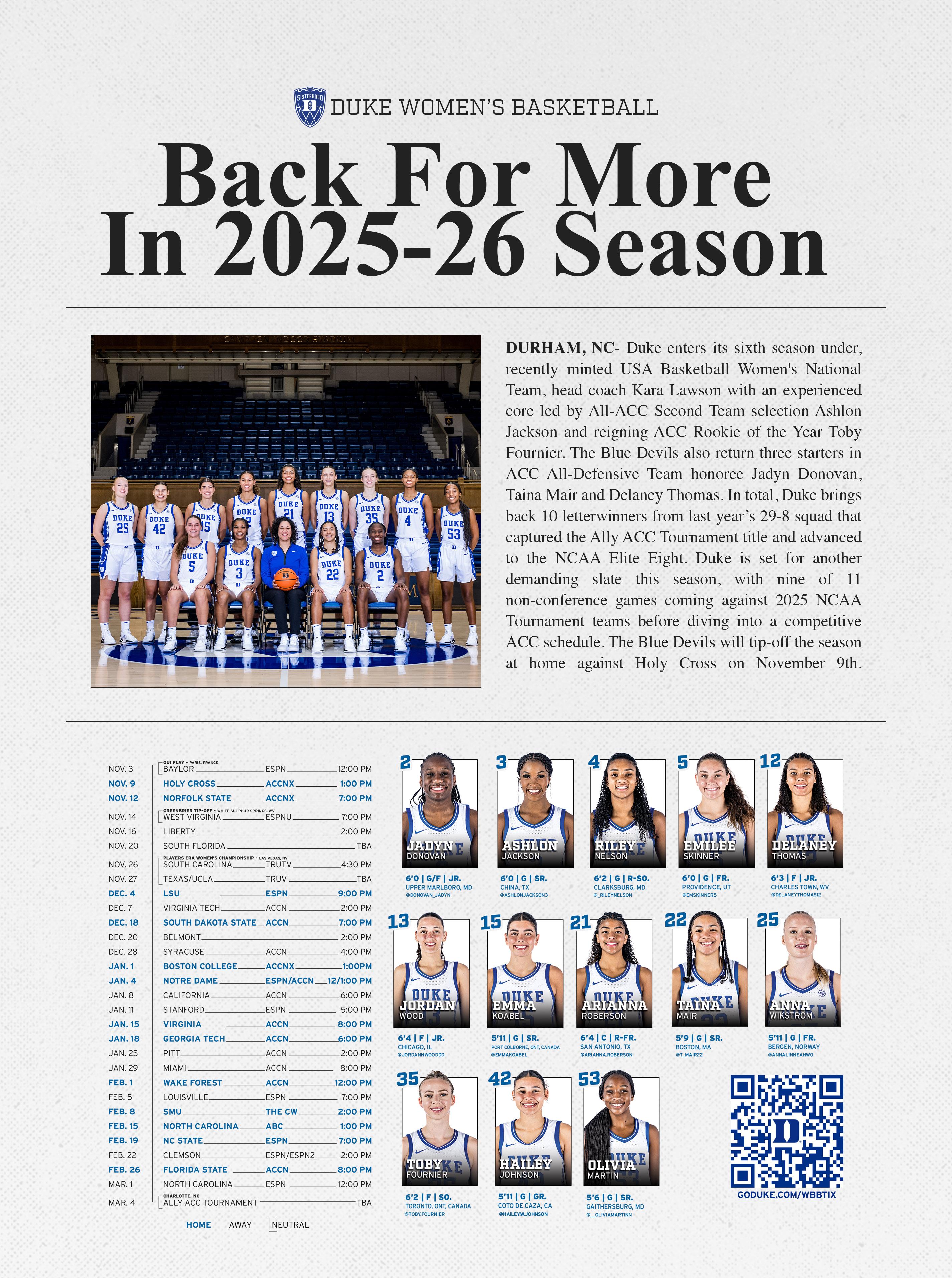BACKTOTHE
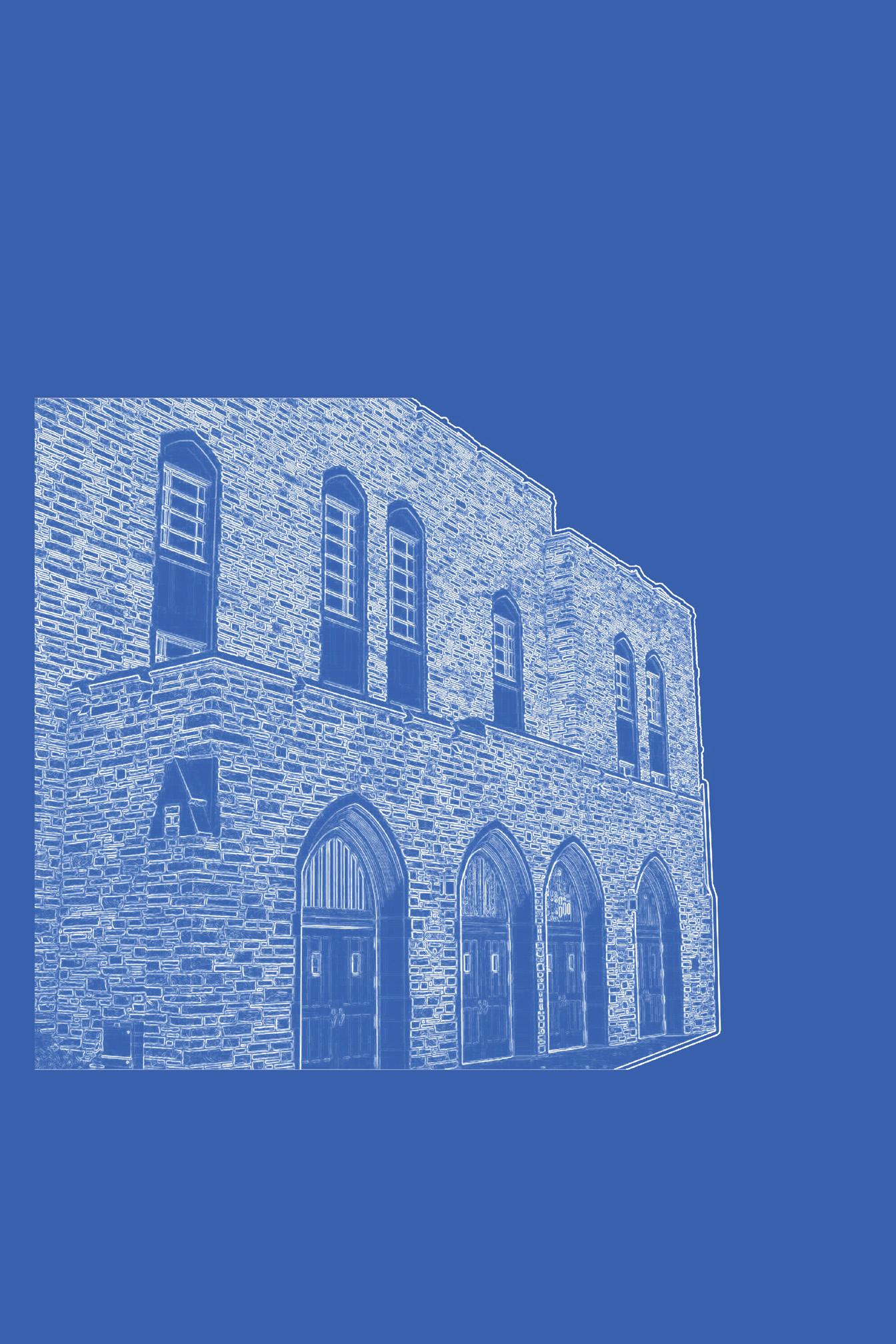

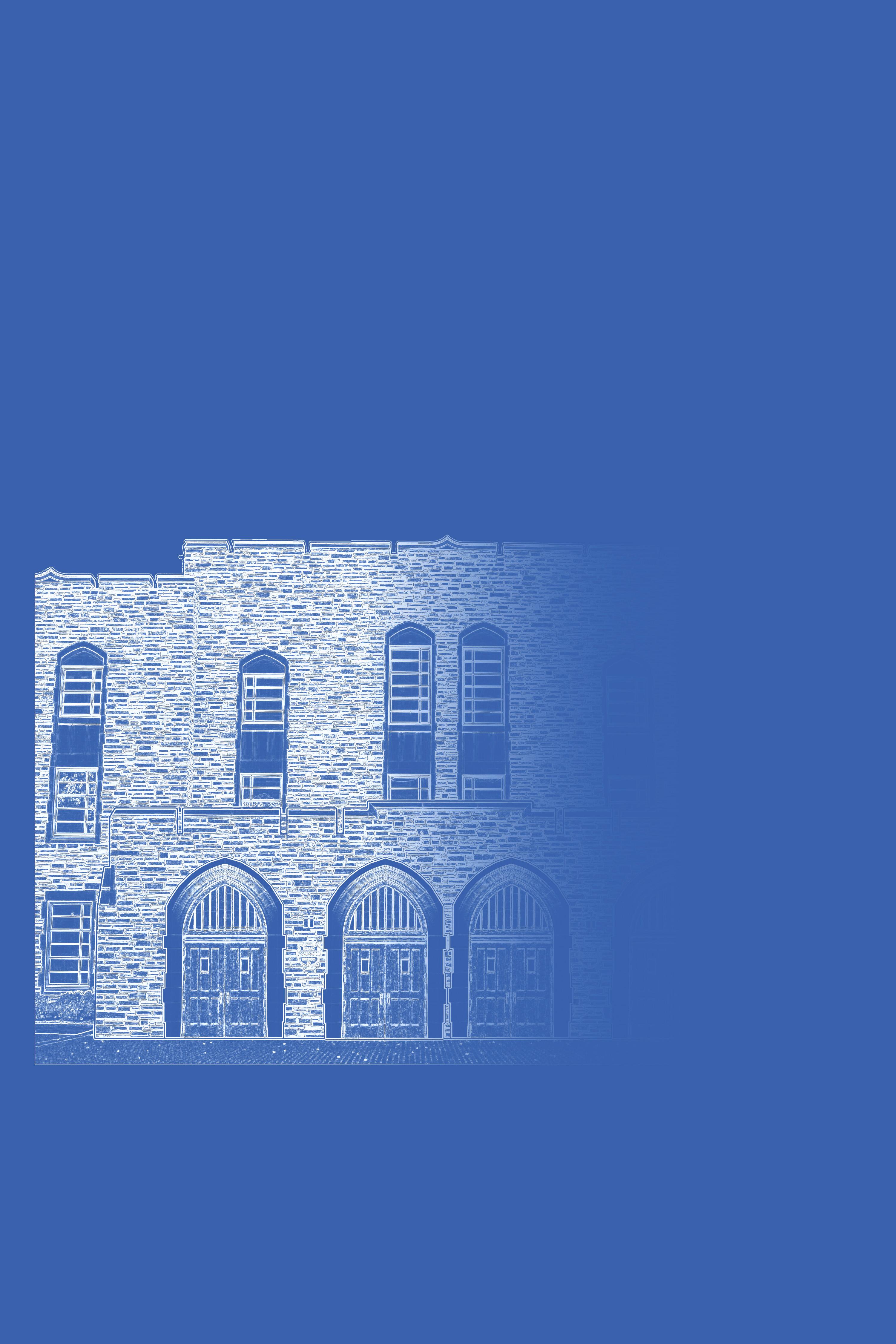
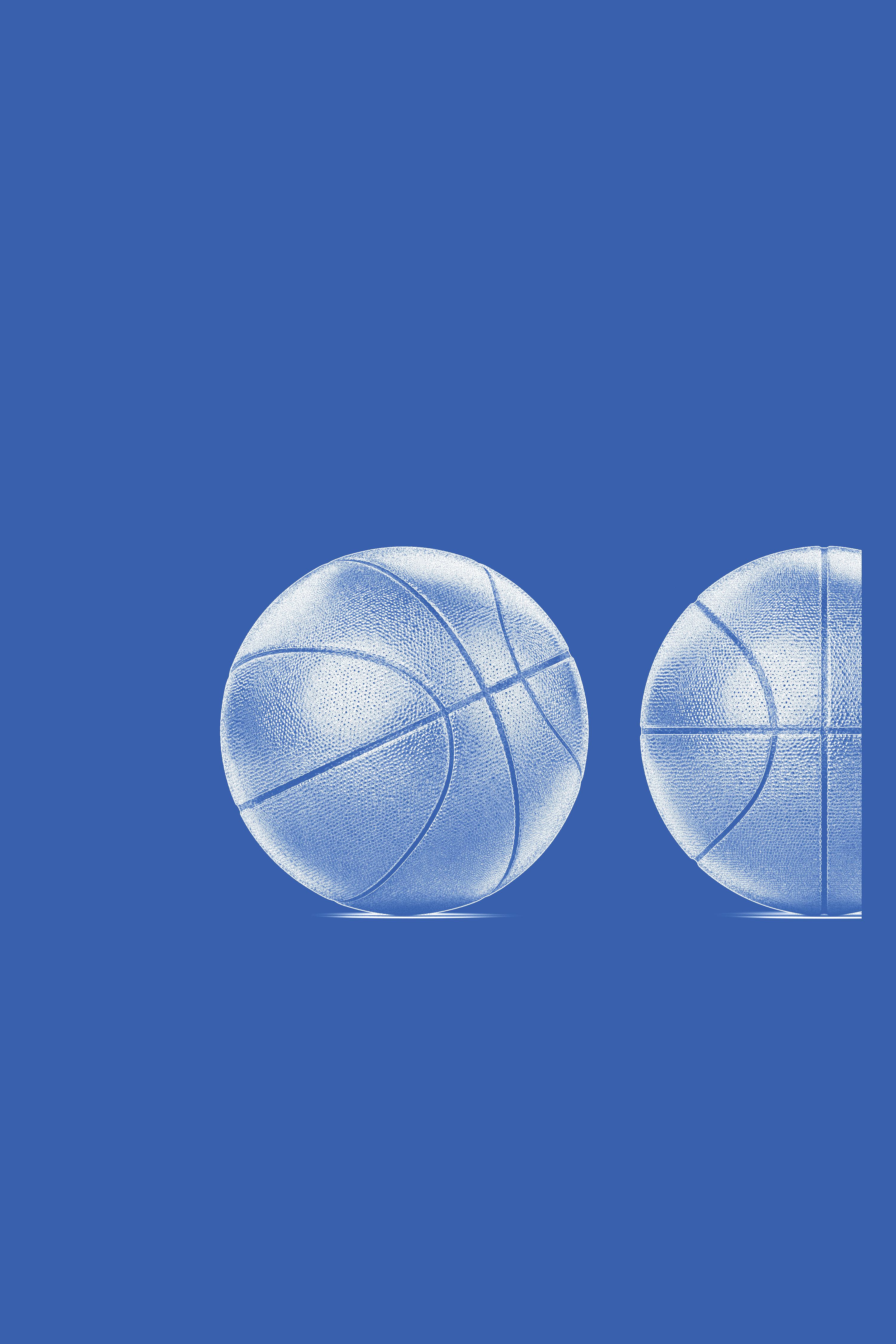



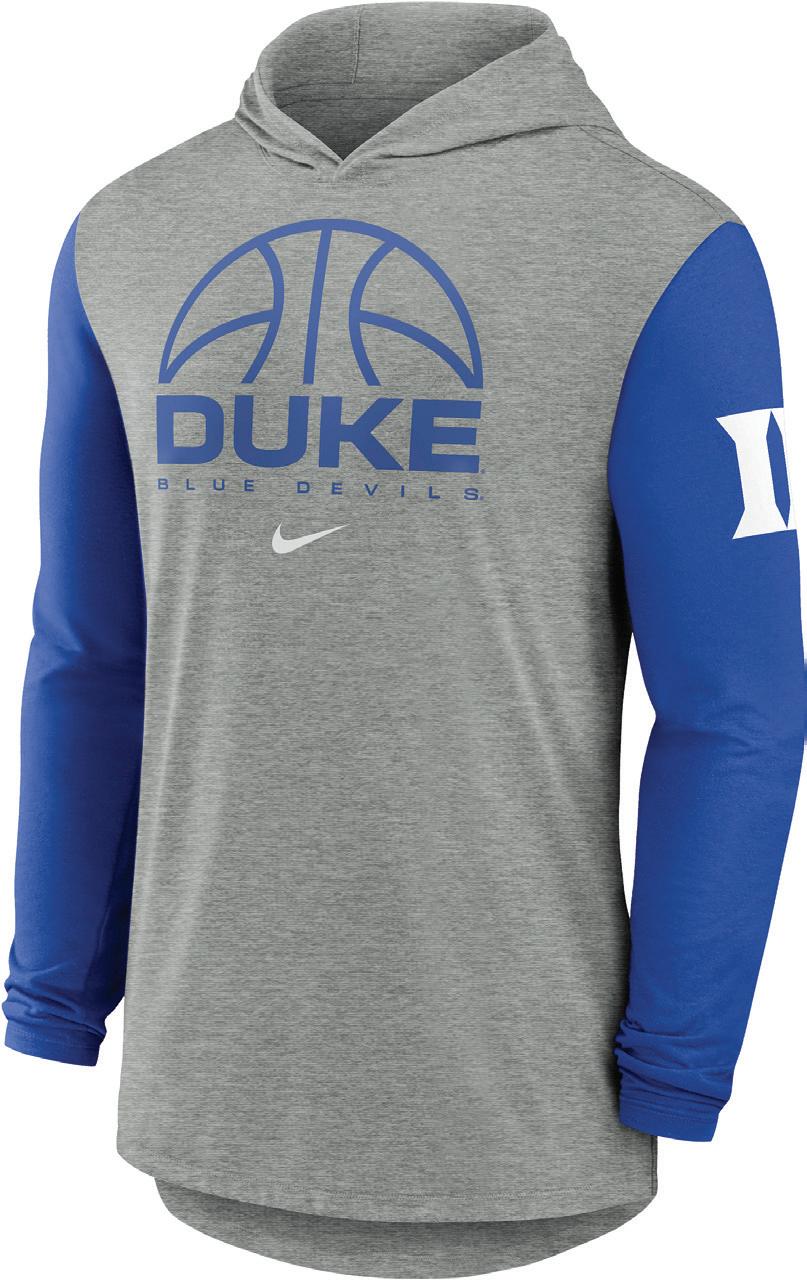


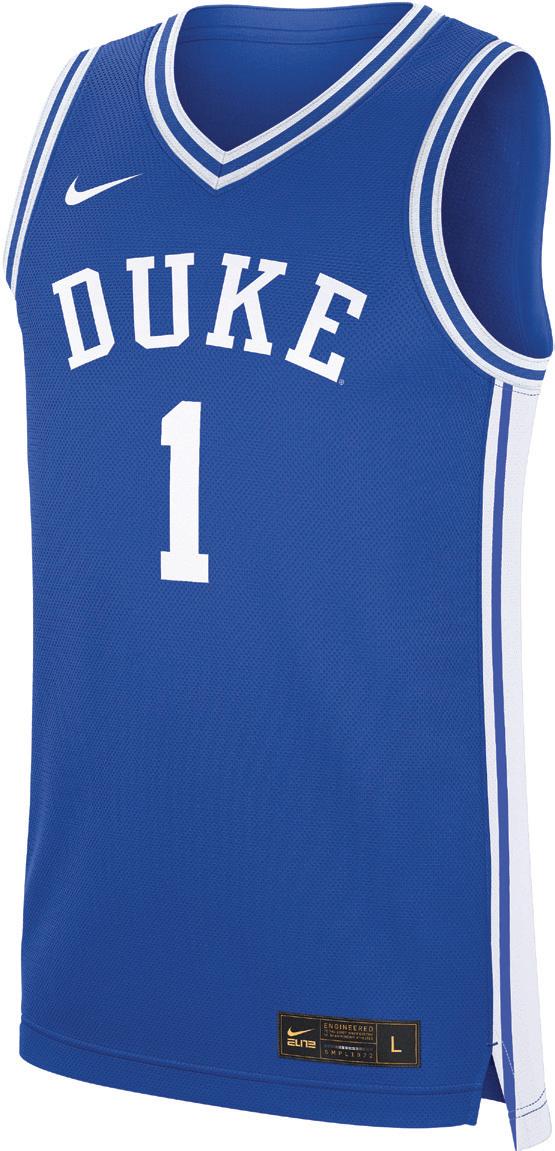
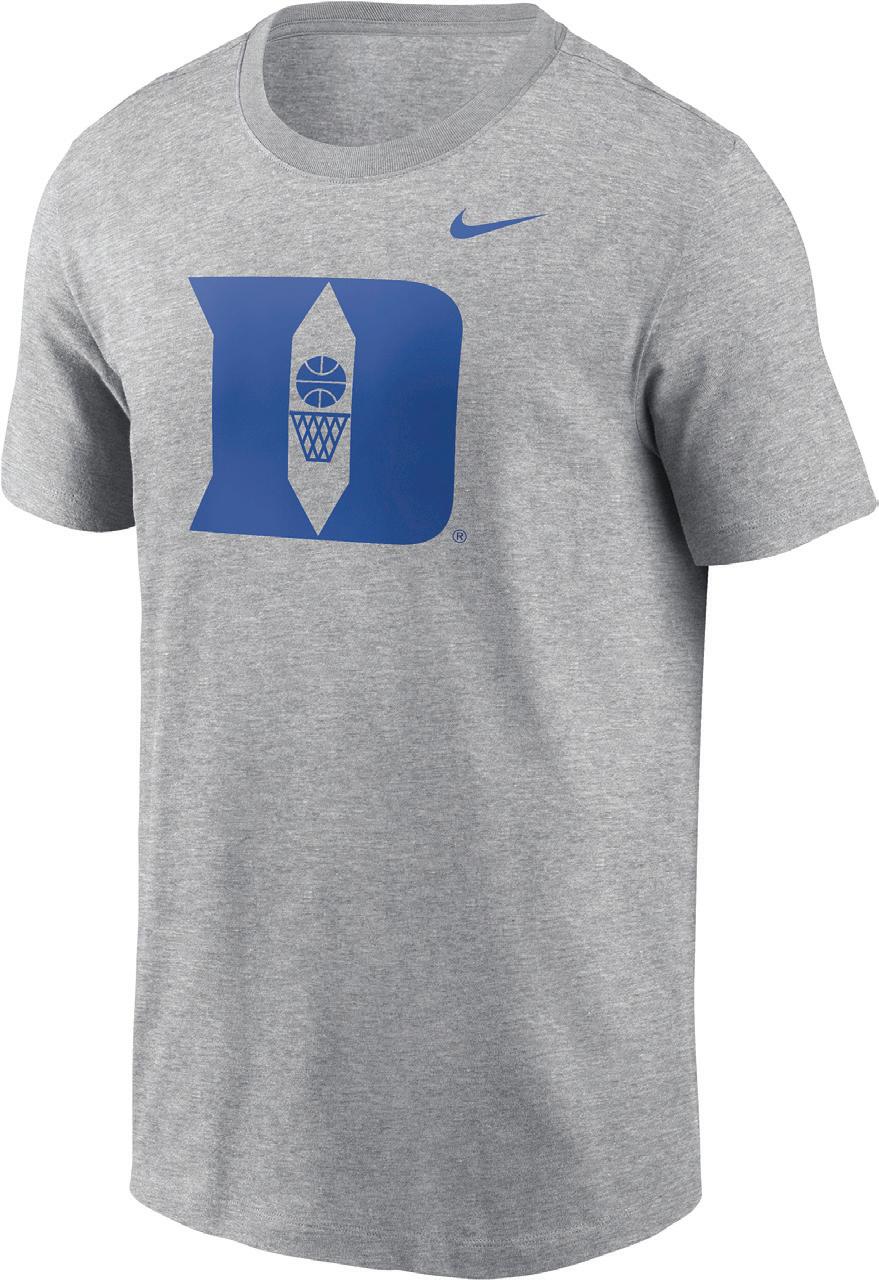






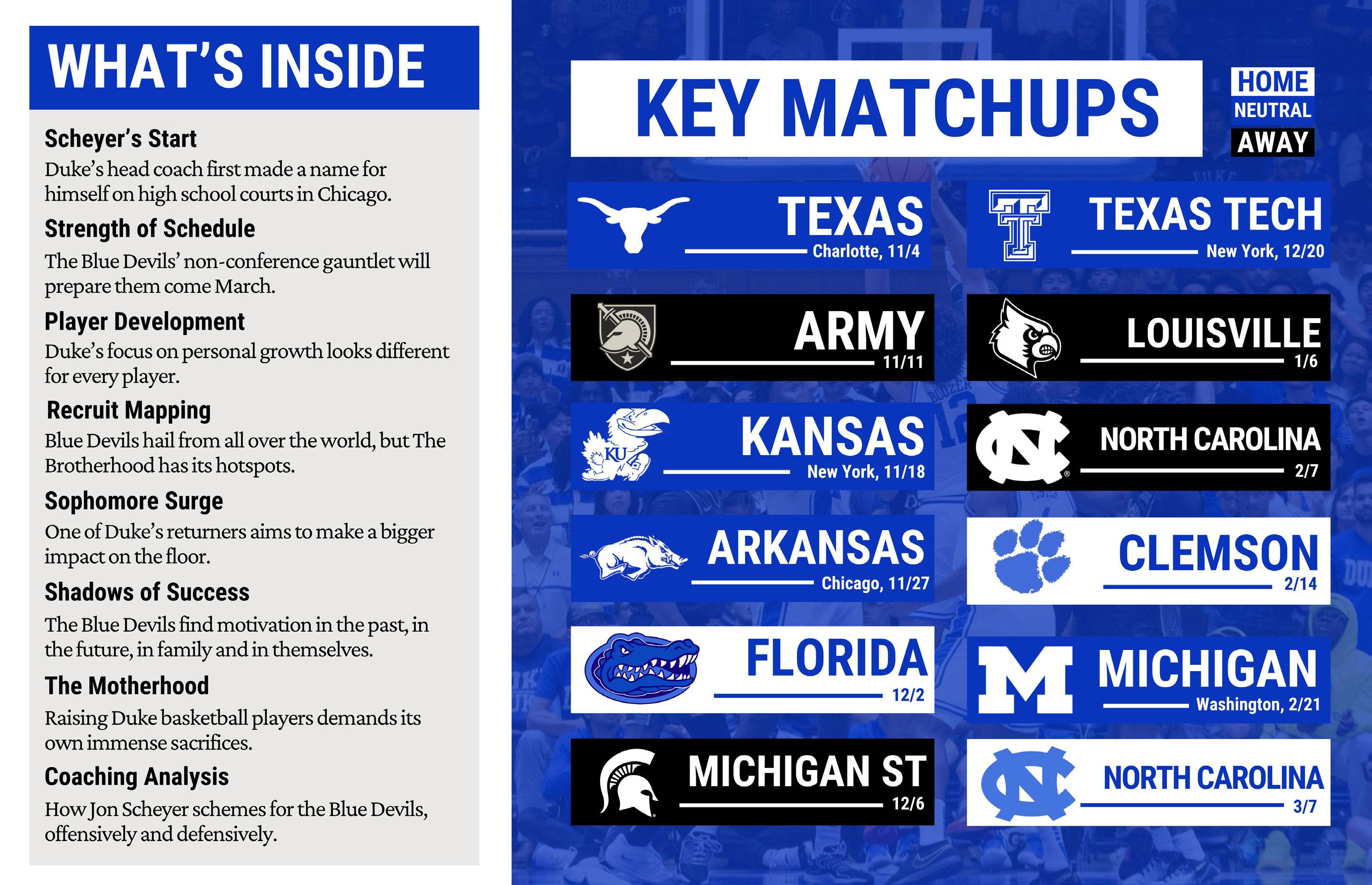






















By Colton Schwabe Blue Zone Editor
Twenty years before Houston’s lategame push to stun the Blue Devils in 2025’s top-seeded Final Four matchup — nearly to the week — a young Jon Scheyer stood in front of a microphone at the end of another tournament journey: the Illinois High School Association’s March Madness. Within the confines of Bradley University’s Carver Area in Peoria, Ill., the 17-year-old had just won the Illinois high school state championship for his hometown team, the Glenbrook North Spartans, earning player of the game honors with a 27-point performance.
“I can’t even describe how great my teammates stepped up tonight,” he said as his first assessment.
A reporter asked Glenbrook North head coach Dave Weber about his star player.
“He really gets kids ready to play,” Weber said. “He’s going to do that next year, and he’ll do that in college.”
No one could have anticipated the extent to which Scheyer would get kids ready to play college basketball. Three years after assuming the helm of Duke men’s basketball, the coach’s 89 victories in his first three seasons as head coach tied the Division I record held by Brad Stevens (Butler) and Brad Underwood
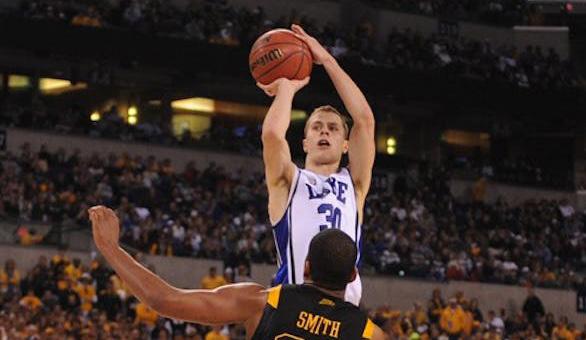
“He was so much more competitive than the average high school basketball player,” Weber told The Chronicle. “No one outworked him on the court.”
As Scheyer loaded his stat sheet — eventually leaving high school as the only player ranked top-10 in the state in points, assists and steals — word spread until he was eventually considered among Illinois’ best.
“Jon’s senior year, I don't think anything affected him. Everybody was following him, like, everywhere we went. The gyms were packed and everybody wanted to see him play,” Weber said. “He just loved that moment. He loves the spotlight, and he took advantage of it.”
In a game against Proviso West his senior season, the Spartans risked losing their 35-game win streak. They trailed by 13 points with just over 90 seconds to go.
(Stephen F. Austin). His Blue Devil playing career and coaching tenure are well-documented, but lesser-known is the Duke head coach’s claim to fame before he suited up in Cameron Indoor.
21 in 75
Playing in leagues around Evanston, Ill. — north of Chicago — through his middle school years, Scheyer entered Glenbrook
North with his fair share of confidence.
The only freshman in the Spartans’ starting lineup, he would soon establish himself as a key piece in the program as he helped lead his team to a third-place finish in the state tournament.
Over time, he built his game. Characterized by consistent shooting and pure hustle, Scheyer’s superpower was effort, both in games and in preparation.
Scheyer went on to steal inbound passes, hit long-range 3-pointers and score 21 points in 75 seconds of the closing moments of the contest. Unfortunately for Glenbrook North, the effort was to no avail, as the team suffered the 85-79 defeat; the future Blue Devil finished with 52 points in front of the packed gym.
NBA star Patrick Beverley, a part of the same high school class as Scheyer in Chicago, recalls the Scheyer phenomenon around the region.

“There were m—f—rs in the projects walking to [Scheyer’s] games … He had a stardom that no other kid had in Chicago, and his school wasn’t even in Chicago,” Beverley said on his podcast last March.
After averaging 32 points per game in his senior campaign, Scheyer went on to win Illinois Mr. Basketball, earn McDonald’s All-American honors and join the Blue Devils.
‘A hotbed’
The 2000s was a big decade for Illinois high school basketball. A generation of kids whose formative years coincided with the Chicago Bulls’ pair of three-peats was making its way to the high school leagues. Naturally, passion for basketball was at a high — especially in and around the city. The upper echelon of regional play has always been highly concentrated with teams from the Chicago Public League, which corresponds to high schools in the Chicago Public Schools system.
“The Chicago Public League was wellknown,” Weber said. “[Chicago and its suburbs] used to be a hotbed.” Future NBA stars like Beverley and future league MVP Derrick Rose built a name for themselves across league play.
Scheyer’s hometown of Northbrook, Ill. — a suburb of around 35,000 — sits about 25 miles north of the city proper. His Spartans wouldn’t typically face Public League teams in regular season play, and so he had to wait until the state tournament to face off against the city’s best.
Glenbrook North fell at the hands of Rose’s Simeon squad in the state tournament Scheyer’s senior season.
“[Simeon] played a box and one on Jon, and they had athletes that could guard him,” Weber said. “It was a rough night.”
Weber recalled a particular showdown between Glenbrook North and Indianapolis’ Lawrence North in Northwestern’s Welsh-Ryan Arena. The team from east of the border — at the time ranked first in the nation — starred future NBA All-Star Mike Conley and first-overall pick Greg Oden.
Scheyer led the game in scoring with 33 points as his team went on to pick up its second loss in 47 games to the pair of Ohio State commits.
The Spartans didn’t lose again in Scheyer’s Illinois Mr. Basketball season before meeting Rose and his Simeon squad in the State Final Tournament.
He had a stardom that no other kid in Chicago had, and his school wasn't even in Chicago.
NBA
“That was a crazy ticket to get,” Weber said. “People were like ‘I sold a ticket for $100.’”
‘Different bodies’
After the Northbrook native’s four years with the Blue Devils, he went undrafted to the Miami Heat in time for summer league. In the team’s summer league opener, Scheyer’s only 3-pointer of the

Reviews of senior administrators of the University are performed on a regular cycle and are administered through the work of a committee that is charged with conducting the review, summarizing input, and preparing a confidential report. Typically, these reviews occur in the fourth year of the administrator’s five-year term. The Board of Trustees has convened a committee to review President Vincent E. Price, who has served in his post since 2017. The committee includes: Trustee Patty Morton, as chair, Trustees Nancy-Ann DeParle, Andy Dillon, Sydney Hunt, Michael Rhodes, and David Taylor, and Professors Kathy Cooney, Mark Anthony Neal, Adrienne Stiff-Roberts, and Larry Zelenak.
The Presidential Review Committee welcomes information from members of the university community. Information provided to the committee will be held in confidence but may be reported without attribution as part of the summary report that will be submitted to the chair of the Board of Trustees. Please note, communication should include the nature of your interactions with President Price and/or his team in order to understand the context of your comments as fully as possible.
Comments should be submitted by Monday, Dec. 15. Please send to:
Presidential Review Committee
Presidential Review Committee
Duke University
Patty Morton, Chair Box 90030 Durham, North Carolina 27708
Email: pres-review@duke.edu
game served as the game-winner. In the contest that followed, he was poked in the eye by Joe Ingles and suffered a serious eye injury. Scheyer received surgery to repair his eye, but Duke’s head coach never repaired his confidence fully on the court. After three years of playing in international leagues, the former Blue Devil made his decision to ultimately join the Duke coaching staff a decade before he was promoted to head coach.
What makes Duke’s leadership unique to that of similar caliber programs is the fact that its head coach isn’t too far removed from an accolade-filled high school and college career. Weber says it affects the team’s play style.
“Last year, when I watched Cooper Fla gg, my son and I always said, ‘we're watching Jon play,’” Weber said. “Obviously Cooper is more talented, but it was like watching Jon play. Not physically, but just the drive and the desire … You can see Jon in his players. You were watching Jon Scheyer play, just in different bodies.”
And the coach’s playstyle isn't the only relic of his high school years that lives on with Duke basketball. His unwavering competitiveness can be seen in how he schedules his games. The Blue Devils are set to play seven non-conference teams in the AP top-25 preseason poll this season.
Time will tell if Duke’s young squad will learn to play its best basketball in big games like its coach did in his playing years, but if one thing’s for sure, Scheyer won’t be backing down.






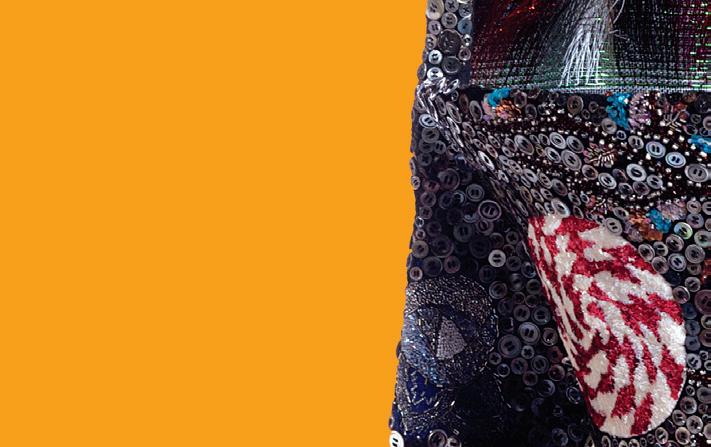
On view through Jul 26, 2026
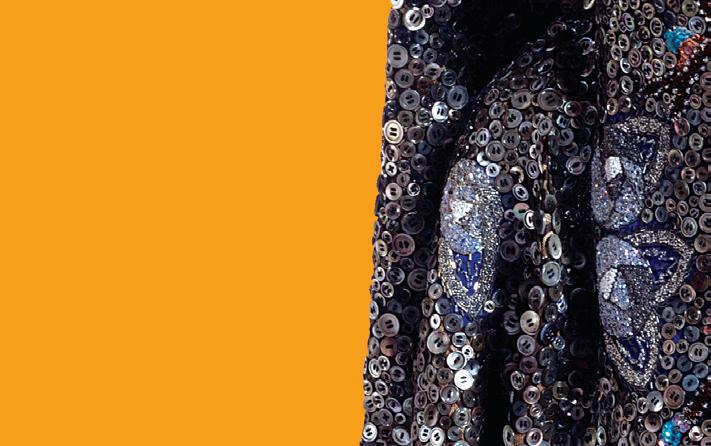
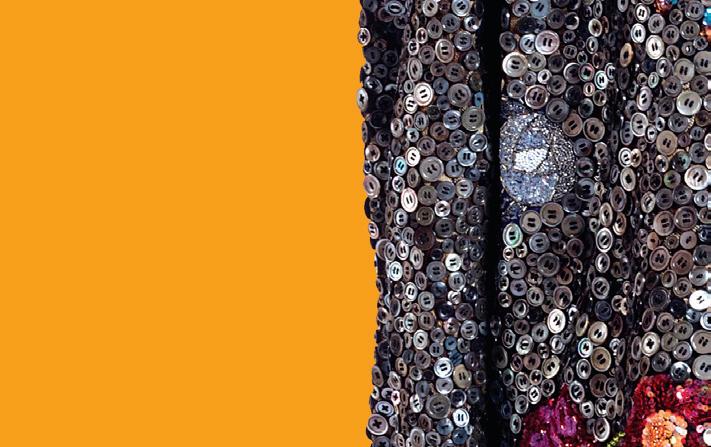

Celebrate 20 �ears of bold vision at the Nasher Museum of Art with Ever�thing Now All at Once—a d�namic anniversar� exhibition featuring landmark works, including Nick Cave’s electrif�ing Soundsuit

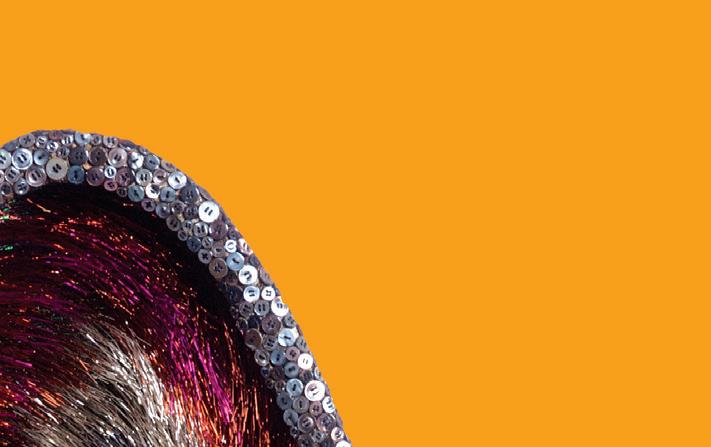
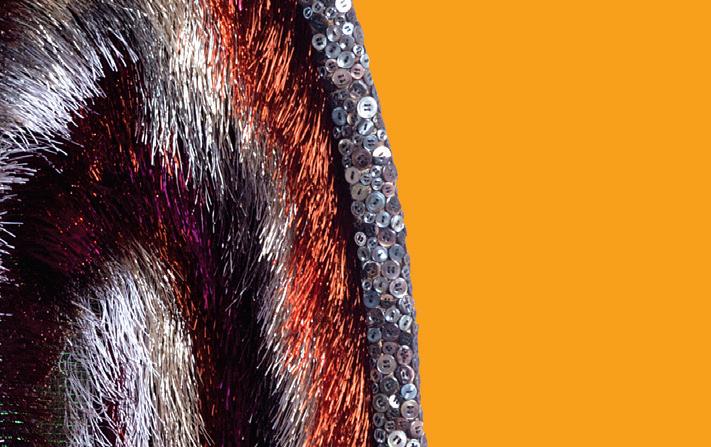


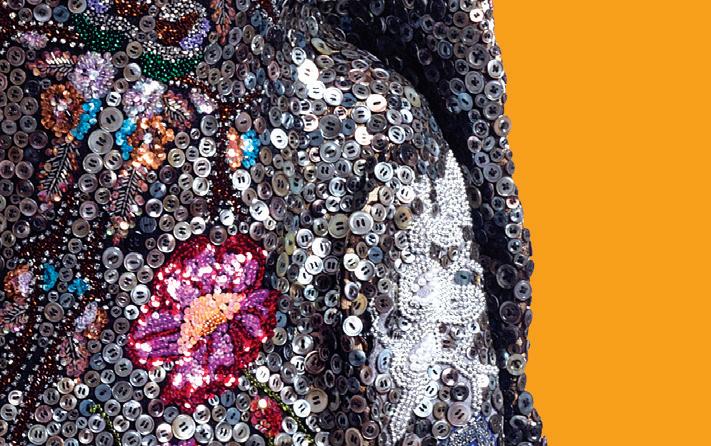

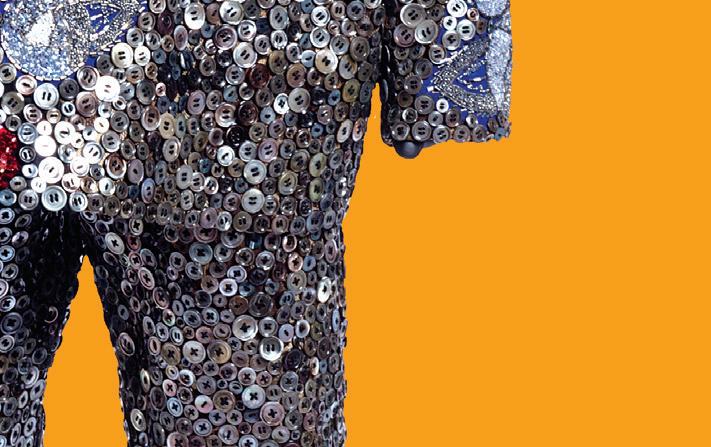










Ever�thing Now All At Once is organized b� Xuxa Rodríguez, Ph.D., Pats� R. and Ra�mond D. Nasher Curator of Contemporar� Art, with support from Julianne Miao, Curatorial Associate. This exhibition is made possible b� The Nanc� A. Nasher and David J. Haemisegger Famil� Fund for Exhibitions and the Mar� Duke Biddle Foundation. Nick Cave, Soundsuit, 2015. Mixed media including wire and bugle beads, buttons, sequined appliqués, fabric, metal, and mannequin, 109 × 29 × 19 inches (276.9 × 73.7 × 48.3 cm). Collection of the Nasher Museum of Art at Duke Universit�, Durham, NC. Museum purchase with additional funds provided b� the Office of the Provost, Duke Universit�, 2016.3.1. © Nick Cave. Image courtes� of the artist and Jack Shainman Galler�, New York. Photo b� James Prinz Photograph�.




By Elle Chavis Sports Managing Editor
Scheduling non-conference games in the modern era of college basketball can be an art. Coaches must balance playing quality opponents to boost their tournament resumes come March with the fact that they also want their teams to earn wins. Looking at the Blue Devils’ 202526 non-conference schedule — which boasts some of the top teams in the country — it isn’t clear which objective head coach Jon Scheyer prioritized more.
“Our schedule we have this year is one of the craziest, if not the craziest schedule I’ve ever seen,” senior forward Maliq Brown said at ACC Tipoff.
As a part of ESPN’s Basketball Power Index — the prediction of a team’s success throughout the season — each team in Division I is given both a non-conference strength of Schedule (NC SOS) and a pure strength of schedule (SOS) ranking. In an era where the strength of the ACC varies greatly, Duke’s SOS has ranked at 43rd, 44th and 34th nationally over the past three years.
During the first two years of Scheyer’s tenure in Durham, the Blue Devils played a typical nonconference schedule, headlined by games against then-No. 6 Kansas in 2022 and then-No. 12 Arizona in 2023. Duke’s NC SOS checked in at 16th and 25th those years, respectively.
Last season, the Blue Devils' NC SOS jumped up to fifth in the nation, making it the only team in the ACC to rank in the top 10.
Duke played four non-conference opponents who were ranked at the time of competition: No. 19 Kentucky, No. 17 Arizona, No. 1 Kansas and No. 2 Auburn, walking away with two wins and two losses.
“I explained to them, the reason we've done this schedule is to make us stronger for the end of the season and to get better,” Scheyer said after the team’s Nov. 26 loss to Kansas last year. “We're not running from anybody. We're not avoiding playing any top team.”
This season, the Blue Devils have managed to up the scheduling ante. Of the non-conference teams Duke will take on, Florida, Texas Tech, Michigan State, Kansas and Arkansas are all ranked in the AP preseason poll. While other non-conference foes like Texas and Army may not have AP preseason ranks, they will surely provide challenges for Scheyer’s squad, especially Army, the Blue Devils’ first true road game of the season. The other road game Duke has on the docket comes in a trip to East Lansing, Mich., to take on Michigan State, the preseason No. 22.
“Oh man … I wasn’t seeking this game out,” Scheyer said at ACC Media Day, referring to the Michigan State contest. “From the Covid year, we had played this game at home during Champions Classic … and we basically said we returned the game, and we're returning the game.”
Two true non-conference road games in hostile environments early on in the season will certainly test the strength of Duke’s burgeoning chemistry.
“Several nights, I stay up a little bit later thinking, ‘What did I do?’” Scheyer said. “In the moment, it definitely made sense. I think it makes sense. But there's no question it's going to be challenging and exciting.”
In addition to the Blue Devils’ trips to West
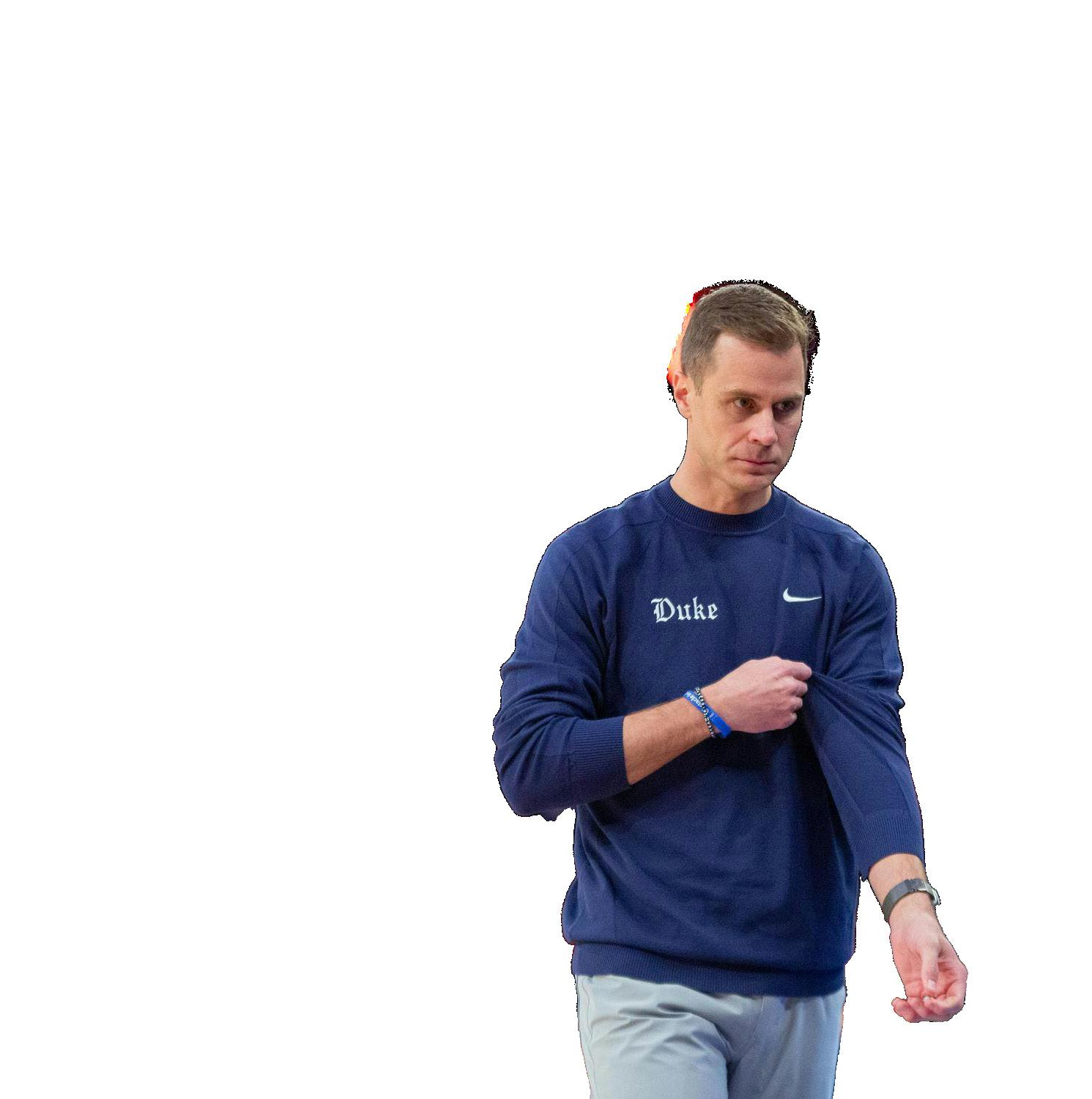
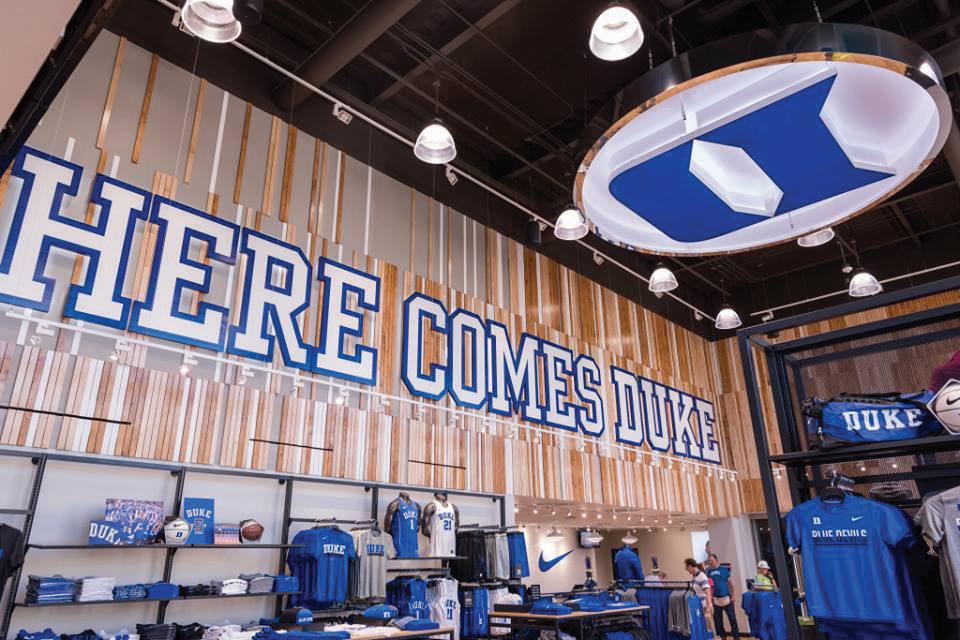
where a familiar foe awaits in North Carolina transfer Elliot Cadeau. Playing a highly-touted Wolverines program late in the season will be the perfect opportunity for Scheyer’s squad to showcase whether or not the lessons learned early in the season benefited it.
The Blue Devils’ difficult non-conference schedule has benefited them in the past. Despite Duke’s heartbreaking loss in the Final Four to Houston, the lessons the Blue Devils learned early on in the season certainly contributed to its nearly perfect 19-1 conference schedule and ACC Championship crown. For a young team with limited experience playing together, going up against the toughest teams the country has to offer will prepare it in a way no scrimmage or practice drill can.
By the time the calendar turns 6, the Blue Devils will have played some of the best in the country. Does it matter if those games are wins or losses? Or is it more important that this team comes away with lessons that will carry it deep into the postseason, equipped for whatever the ACC and NCAA may throw its way?
If Scheyer has his way, the latter will prove true regardless of the former.
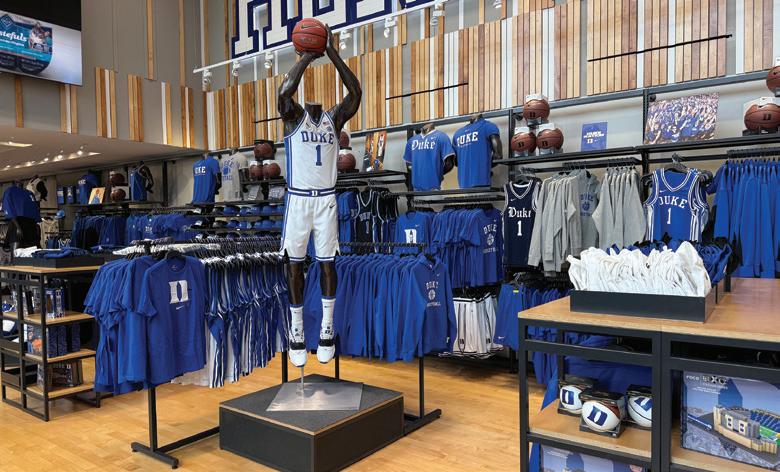
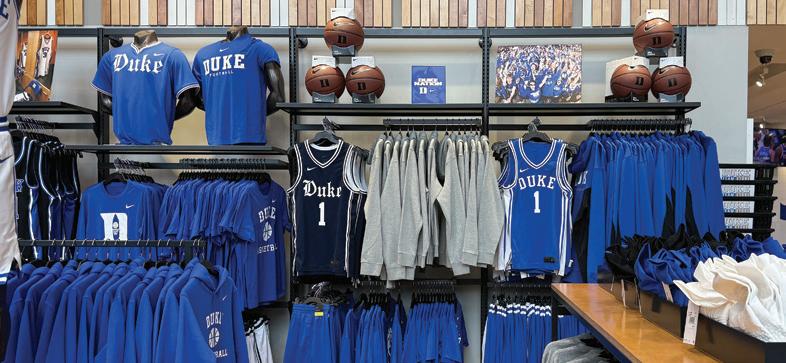
By Ranjan Jindal Senior Editor
Caleb Foster knew he made the wrong read.
New assistant coach Evan Bradds had his hands behind his back when closing out to guard Foster, but the junior drove the ball instead of shooting. Foster’s slight hesitation and pump fake drew the ire of Bradds, who wanted Foster to take the open shot.
“Turnover,” Bradds yelled. “If you make the wrong decision or you jab, I’m calling turnover. All those shots you shoot C-Fos, let it go.”
This is one of many individual drills that coaches including Bradds were brought to Durham to lead. It’s part of each 2025-26 player’s “blueprint time,” as head coach Jon Scheyer calls it, or the structured time every day before or after practice for players to polish their craft. It doesn’t have to be individual; often it’s 2-on-2 or 3-on-3. Live bodies are essential. The coaches constantly switch up the situations and shots to mimic a live game format. It’s one thing to have the skill to make the play, but it’s another to understand what decision to make at what time and how to execute.
“[We want] any player on our team, regardless of position, to attack the paint off of a closeout, for example, get to the paint and know what their reads are based on our spacing,” Bradds told The Chronicle. “We want these guys to understand that this drill is not just a drill, but it's something they're going to see during the game.”
This particular drill, published on Duke basketball’s YouTube, is a 3-on-3 coaches versus players simulation. A player gets the ball in the corner, with the option to drive, shoot or pass to another open Blue Devil shuffling to the opposite corner. A big man is also diving to the basket, providing another outlet for the ball-handler.
“Pretty much that’s all we do is drills and make reads,” Foster said at ACC Tipoff. “It’s kind of simple, but it’s definitely helped everyone with decision-making. And obviously, watching the film over it has helped.”
Because this group is one of Scheyer’s youngest — eight of the projected rotation
players are freshmen or sophomores — the focus on player development is his concerted effort to “speed up the learning curve” in the arduous transition to college basketball.
“We’ve changed some things we’ve done during our practices,” Scheyer said at a Sept. 24 availability. “We’ve invested a lot, with us having such a young team, in the player development aspect. We’ve studied best practices and the best ways we can get just to max out this time period with our guys for whatever time they’re here.”
‘As NBA as possible’
This philosophy isn’t totally new for Duke. Associate head coach Chris Carrawell said player development is “what separated us last year.”
After reaping the benefits of that focus, Scheyer made individual work the focal point of the offseason. The transformation of the Blue Devils’ gameplan started with revamping the coaching staff. In May, Scheyer tapped Bradds, then an assistant coach for the NBA’s Utah Jazz, to join the staff. Bradds cut his chops in the NBA player development waters working for younger teams including head coach Will Hardy’s Jazz team. In the same way that he helped those 18–20-year-olds prepare for their basketball careers, he wants to provide the young Duke roster with the tools to excel here and professionally.
contact on finishes or replicating the countless approaches to ball-screen defense, Bradds and his team simulate the multitude of looks the opposition can give. As in his drill with Foster, the most important part for Bradds has been “making great decisions” and simulating the game.
“I think the best part is just doing skill work before practice, and then you get into a scrimmage in practice, and it’s just so translatable,” sophomore Darren Harris said. “Coach Ty, Coach Bradds, they’ve been amazing.”
Another part of Bradds’ role that comes from his NBA experience is in the offensive scheme. He preaches that mathematically, 3-pointers and layups are the best shots to shoot, and teams should focus on volume shots from those areas. Those were the shots his Belmont teams excelled at.
Bradds called his vision for Duke’s offense “organized randomness,” a difficult-to-scout approach that combines players’ ability to be free flowing and make decisions with a stout offensive structure.
We want these guys to understand that this drill is not just a drill, but it's something they’re going to see during the game.
EVAN BRADDS Assistant
Coach
During his four-year stint as a Belmont forward, Bradds still sits sixth in Division I for a remarkably efficient career field-goal percentage of 66.7%. While injuries curtailed his playing career, Bradds found his calling in coaching. But because of his ascension in the NBA, Bradds never thought he would return to the collegiate ranks, until he received the “once-in-a-lifetime call.”
“Scheyer kind of approached me about trying to make this place as NBA as possible,” Bradds said Sept. 24.
Bradds plays a significant role in players’ individual blueprint. Whether it’s providing
“My goal is to get the best shot every time,” Bradds said. “How we do that varies from team to team, but for me, it starts with our spacing. It starts with having a consistent set of spacing.”
Scheyer illustrated his eye for player development with his second assistant coach hire of the cycle, reeling in former Blue Devil Tyler Thornton May 30. Thornton provides an alternate perspective, having served as player development director at Howard between 2019–25.
“I think the game is turning to a lot more guys being decision-makers, not just the guys that are point guards or lead guards, but having guys at the four and five position who can think and make plays as well,” Thornton said Sept. 24. “So just putting those guys in positions on a day-to-day basis to make reads and execute.”
Carawell thinks that Thornton has an advantage because of his experience at a lower-

level Division I school, where players stay in college for multiple years. And now, coming to Duke with the talent and resource boost, Thornton can use his eye for the college game to benefit the Blue Devils.
To round out the player development staff, Scheyer named Jayce McCain as Director of Player Development in October. The brother of former Blue Devil and first-round pick Jared McCain, Jayce followed his brother in 2023 to Duke after a decorated career for Cal State San Marcos.
Due to his age, McCain is a valued confidant for the team navigating the roadbumps of Duke basketball because of his experience mentoring his younger brother. He works on-call on off days to schedule workouts with the players, again focusing on tailored drills with live bodies and situations.
“You’ve been a game-changer,” freshman Cayden Boozer said to Jayce McCain on The Brotherhood Podcast.
The 98%
A second point of emphasis for these Duke basketball players is excelling in the “98%,” or the time they don’t have the ball in their hands but can still impact the team. A majority of the Blue Devils were balldominant in high school and taught to spend their formative years of basketball with the ball. But the adjustment coming to college is knowing that the team’s needs typically trump individual usage. This connects back to Bradds’ emphasis on offensive spacing and off-ball movement, along with team defense and rebounding.
Another component of the 98% is the mental aspect, or the “next-play mentality.” When Bradds and Scheyer coach, they tell the players to always keep playing and not allow a minor error to ruin the next sequence. Players also have a new mental framing to understand that their preconceived notions of what impacts winning may not align with reality. Foster mentioned that mental coach Russ Rauch has advised the team on
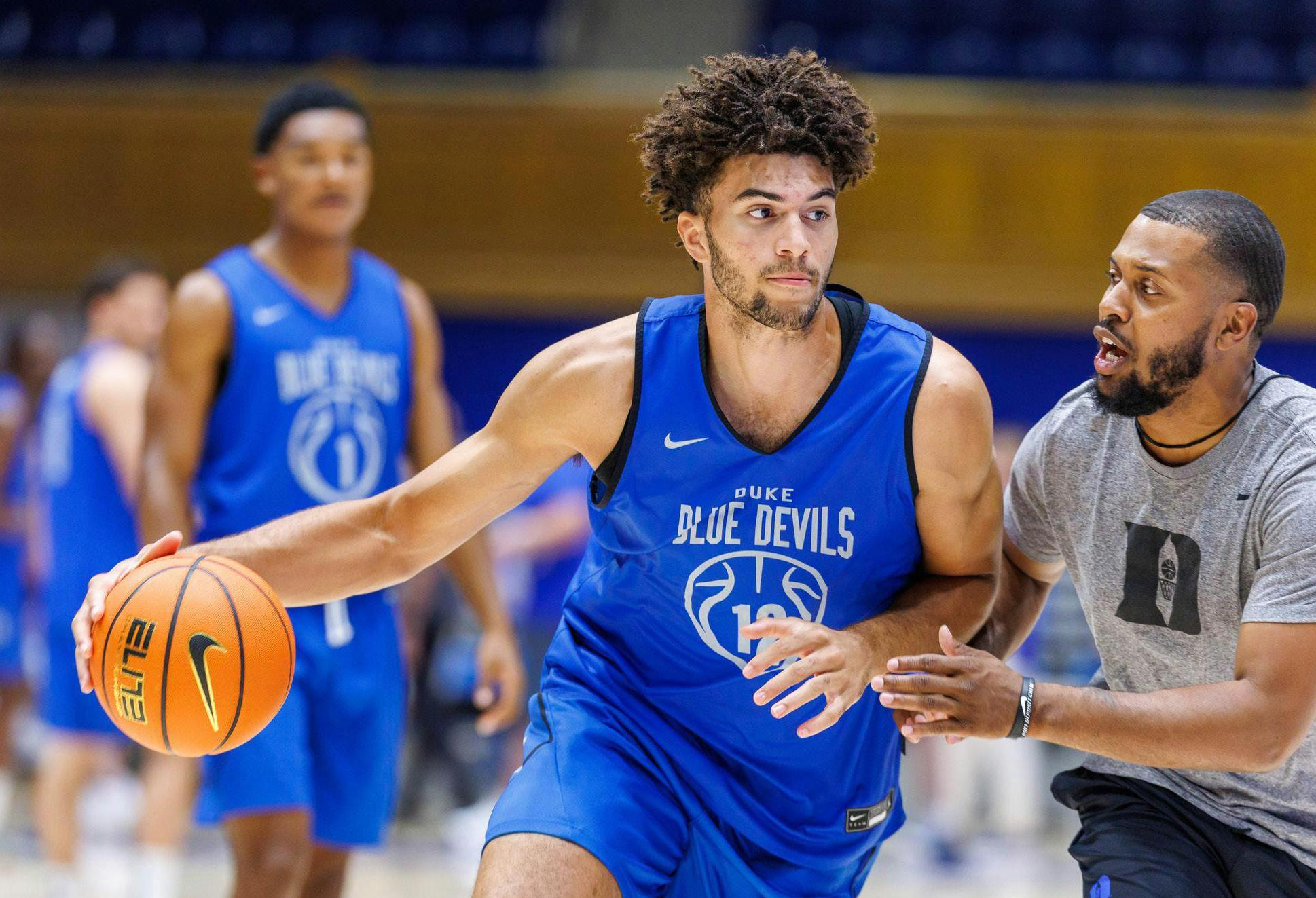

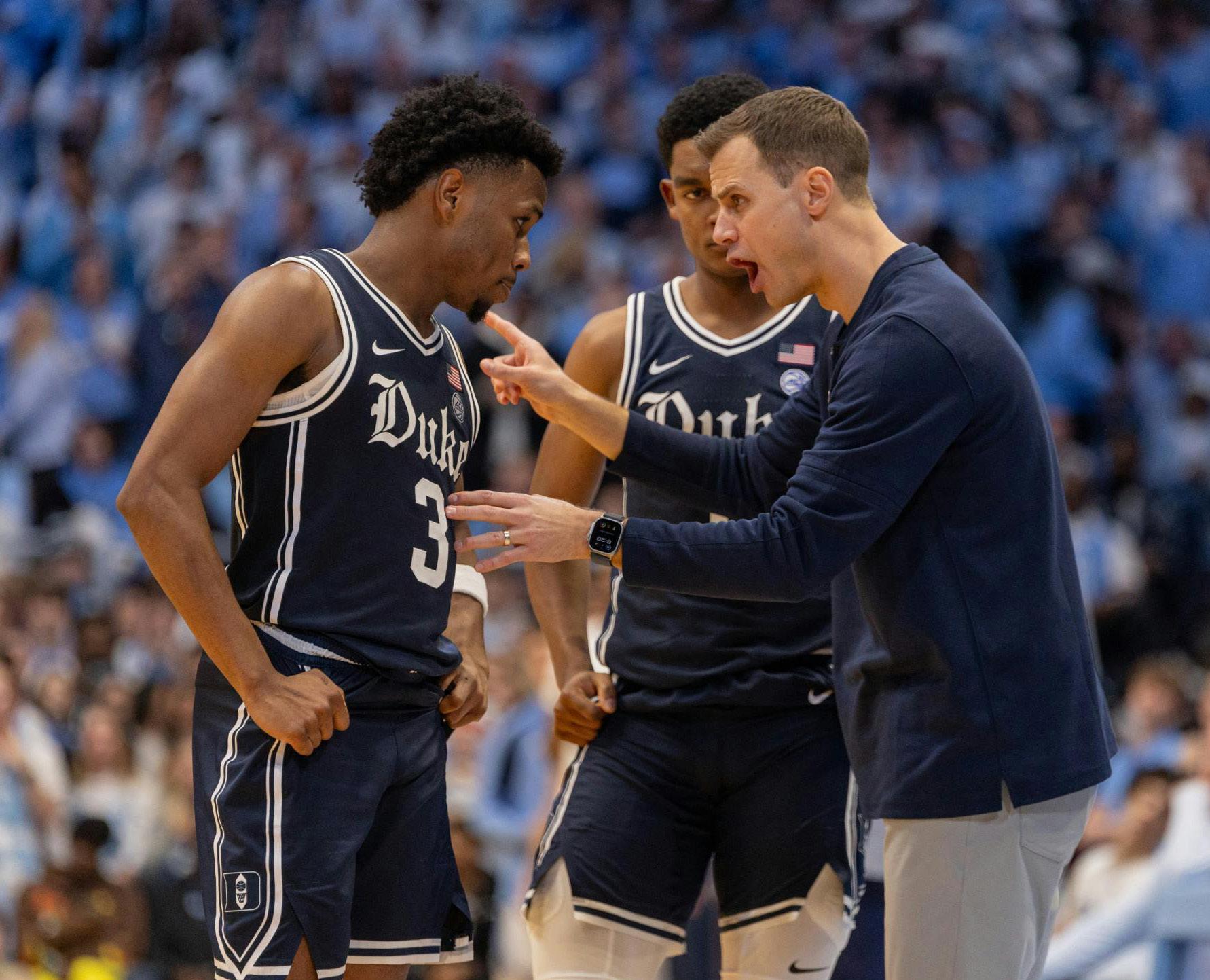
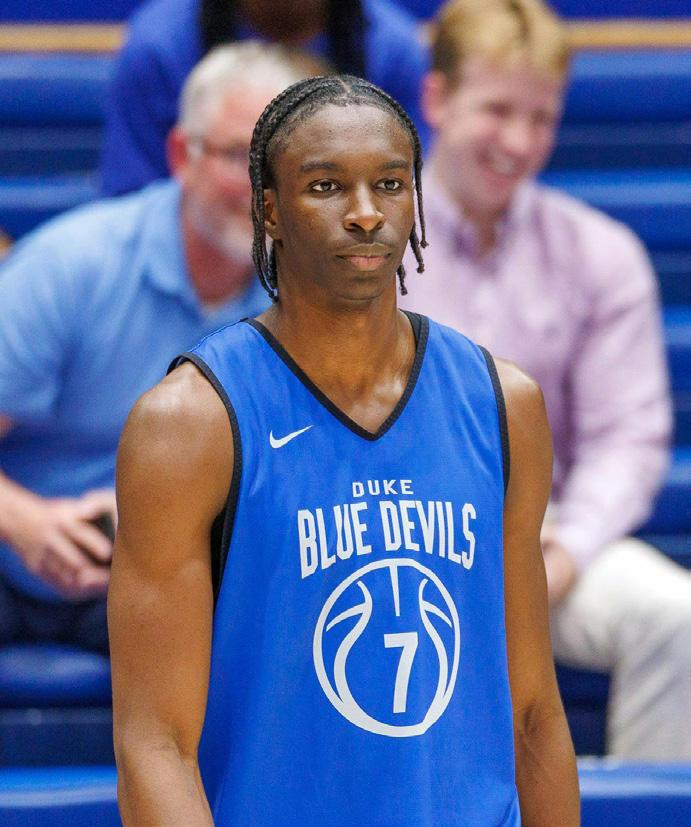
By Caleb Dudley Sports Multimedia Editor
Being recruited by Duke basketball is a special thing. Even a dream for some. But where does the storied program pull most of its talent from?
Starting with the legendary 201415 recruiting class, there have been 62 freshmen on the Duke basketball team. Notably, this figure excludes transfers and most walk-ons who never earned consistent playing time. Let’s take a look at what the numbers on recruiting in Durham say, as well as hear from some coaches who have played a major role in the journeys of these top freshmen.
The increased visibility of top recruits and the rapidly-growing economic opportunities associated with youth basketball have increased the percentage of recruits entering Duke from private schools, usually those that prioritize nationally-competitive sports programs. Of the 62 newcomers, 43 spent at least their senior year at a private school. Over the past five recruiting classes, only two players have stuck at a public school for four years: Isaiah Evans and Jared McCain.
For many seeking to play at the next level, it can be a wise decision. Private schools often have connections with college coaches, schemes designed to prepare players for Division I competition and more resources to dedicate to player development. However, not every top prospect leaves their hometown behind, opting instead to create a lasting legacy at their local high school.
Take Brandon Ingram as an example. Matriculating to Duke as the No. 3 player in the country, Ingram did not spend any of his high-school days as a large private school. Far from it, actually. The now-NBA All-Star’s journey runs through Kinston, N.C., a small town roughly two hours east of Durham.
Despite its low population — 19,181, according to World Population Review — the town has a vibrant basketball culture.
In fact, Kinston produces the most NBA players per capita of any place in America. For Ingram, there was no need to leave Kinston for better opportunities. Anything the youngster needed was right at his fingertips, even in a tiny town in eastern North Carolina. The result: four state championships, a local impact that is still felt today and a load of recruiting memories for Ingram and his head coach.
“His last five were Kansas, Kentucky, UCLA, Duke and [North] Carolina … and it was pretty crazy,” Kinston High School head coach Perry Tyndall said. “I mean, it was just everybody. But Duke moved the needle for him, and there was no doubt about it ... Their vision and their pitch, even being in late, it was impactful for him.”
As with any sport, there are geographic areas that tend to produce top talent at a higher rate, like Texas or Florida for college football. That’s true for hoops as well, especially at a school as nationally known as Duke. Across the country, Florida schools are the top producer of Blue Devil ballers with 11, closely followed by Virginia with seven, California with six and North Carolina with five. Other notable pipelines, with three recruits apiece, include Georgia and head coach Jon Scheyer’s local Illinois.
A large number of the Florida recruits are like many Florida residents — transplants from different states. Of Duke’s 11, six grew up outside the Sunshine State. Four former Blue Devils came from Montverde Academy, a prep school notorious for pumping out NBA-caliber talent under legendary coach Kevin Boyle. The majority of the players at Montverde don’t hail from Florida due to the school’s national recruiting approach, so it may not come as a surprise that only one of the school’s Duke connections is a Floridian: Sean Stewart. It’s a similar story at powerhouse IMG Academy. The two Blue Devils that attended IMG, Trevon Duval and Mark Williams, both transferred across state lines at some point during their highschool days.
Virginia is another unique case, largely because of the interconnected nature of basketball in the DMV (District of Columbia, Maryland, Virginia) area. A high school recruit could grow up in Virginia and easily attend high school in Maryland, or vice versa. Duke has continually brought in top talent from the area over its history. Notable names include national champions Quinn Cook and Nolan Smith along with all-time leading scorer JJ Redick.
However, one school has dominated of late in terms of establishing a DMV–Duke pipeline: St. Paul VI in Chantilly, Va. If the name sounds familiar, it’s because the private Catholic school is the alma mater of two current Duke players, Patrick Ngongba II and Darren Harris. It also was where Jeremy Roach and Trevor Keels played highschool ball.
Obviously, Duke is Duke. It is an elite brand, an elite basketball program, an elite school.
In addition to his role at Blair, Mantegna has served as a coach within both USA Basketball and the South Sudanese Basketball Federation — Deng is the president — allowing him opportunities to interact with players outside of the typical high-school arena. Through this, Mantegna and Blair developed a close relationship with Scheyer and company. Much like PVI, that connection continues to bear possible fruit, as current Blair guard Deron Rippey Jr. just completed a visit to Duke.
DAVID REBIBO
HARVARD-WESTLAKE HEAD COACH
The elite program, led by head coach Glenn Farello, has become a trusted partner to the Blue Devil coaching staff. Scheyer seems unlikely to stray from the well anytime soon, as Duke is in hot pursuit of No. 2-overall recruit Jordan Smith Jr. out of PVI.
“I always welcome them into our gym and into the lives of our players that they want to recruit and see how it all shakes out. Seriously. Fortunately for both sides, PVI and Duke, it's worked out,” Farello told The Chronicle.
Blair Academy is another school with intimate ties to The Brotherhood, this time representing the northeast. In addition to a handful of walk-ons who eventually made it to Durham, the private New Jersey school was where Luol Deng spent his playing days after immigrating to the U.S. from South Sudan. That was in 2002, but the connection has continued into more recent years, with Jaylen Blakes also jumping from Blair to Duke.
Blair’s connection to Duke goes even deeper thanks to head coach Joe Mantegna.
“I was just really impressed by the way that they recruited, and also the way that they sold Duke and then executed on what they said they were going to do," Mantegna told The Chronicle. “Coach K continues to support Luol and the things he does around the world to this day, and so do a lot of Duke alumni, which is exactly what Coach K said would happen when he sat in my living room in 2002.”
Considering Duke’s brand and alumni base, it should make sense that many of the program’s strongest connections sit along the East Coast. However, the brand value of a top basketball program travels quite easily in modern times, meaning Duke has no trouble recruiting players thousands of miles away. In the last three years, the Blue Devils have welcomed two Californians into their ranks, including current freshman Nikolas Khamenia. Despite going to school 2,535 miles away from campus at Harvard-Westlake School, the talented wing had no trouble gravitating towards everything Duke stands for.
“I think Coach Scheyer and Carrawell painted a very, very clear picture, and connected with Nik and his family, which made the decision even easier. And obviously, Duke is Duke. It is an elite brand, an elite basketball program, an elite school,” Harvard-Westlake head coach
By Lucy Glynn Assistant Blue Zone Editor
The national spotlight may hover on Duke’s star-studded newcomers, but inside the Blue Devil program, a different narrative about returning guard-forward Darren Harris is forming.
Within Duke’s locker room, the storyline surrounds his shoes.
At ACC Tipoff, teammate Caleb Foster crowned the sophomore No. 1 sneakerhead. From the customized ‘Tripe White’ Foamposites he stunted at Countdown to Craziness to the lime-green Buzz Lightyear Toy Store Crocs he sported on Duke’s media day, Harris flaunts the title with pride.
But his shoes aren’t the only thing the program is talking about: In the offseason, Harris invested in the program, carving out his role as Duke’s bench weapon.
When Scheyer was asked which returning player he was most excited to see assume a larger role, he pointed to Harris, who seems to be stepping into this season as a completely different player.
“The guy that didn't play as much last year that I think has had tremendous growth is Darren Harris,” Scheyer said. “If you look at his body, versus a year ago, he's done a great job in the weight room and working with our sports performance team. He's just
Two weeks later, Foster doubled down.
“I don't think a lot of people are talking about Darren Harris, but he comes in, he works hard every day,” Foster said at ACC Tipoff. “He keeps developing, getting better and better.”
A season ago, the four-star player spent most of his freshman year watching from the sidelines, squeezed out of the rotation and limited to six-minute court averages. In a year where nearly 2,700 collegiate basketball players hit the transfer portal, that resume might have cued a departure.
Harris didn’t even enter the portal. He chose Duke — again.
“Darren has just been committed — solely, just completely — to Duke, to the process,” Scheyer said at the program’s annual preseason media day in September.
That loyalty traces back to long before Harris’ name ever appeared on the team’s roster. His parents, Kevin and Roxy, were longtime fans, and their obsession became his own.

“After the season ended I changed my diet and it’s definitely been a big benefit,” Harris said. “I think the biggest thing is I just try to get my cardio up. I've been running a lot.”
Harris spent the off-season committed to rebuilding his body — trimming down and toning himself into a competitive wing able to fight for a spot in Duke’s rotation — and the physical transformation is obvious.
“We had a moment when we were coming from the practice facility — he had a good practice — and you look at our Final Four picture, and I'm not gonna say he was overweight,” associate head coach Chris Carrawell said. “If you look at his body now, I mean, he's a machine, and you can tell the difference in him, just in a year.”
He keeps developing, getting better and better.
During last year’s preseason media day, Harris recalled that while he was in fourth grade, his family spotted an open door into Cameron Indoor Stadium and slipped inside to snap a quick photo at the section of the stadium’s hardwood marked “Coach K Court.”
So when Duke started calling — offering the opportunity to make the stadium he once snuck into his home floor — Harris didn’t hesitate. He officially committed in October 2022 and became the first piece of Scheyer’s second No. 1 recruiting haul. And before he ever officially suited up, Harris delivered his first Blue Devil assist: helping bring high school teammate and five-star shooting guard Patrick Ngongba II to Durham.
Harris entered Duke’s roster riding an explosive final year of high-school ball: averaging 17.2 points, 4.5 rebounds, 3.1 assists and 1.9 steals per game while picking up the Gatorade Virginia Player of the Year title. But college brought a harsh transition. Surrounded by nowNBA professionals Tyrese Proctor, Sion James, Cooper Flagg and Kon Kneuppel, the 6-foot-5 newcomer slid down Duke’s bench.
he Fayetteville Observer labeled him the “forgotten freshman,” backed by a modest statline of six minutes, two points, 1.1 rebounds and 0.3 assists per game.
After a heartbreaking ending that left Duke one game shy of the title, returning Blue Devils vowed their comeback would be different. For Harris, the group’s mission became personal.
“A big chip on my shoulder — I think that's kind of been the biggest change from last year to this year: how I mentally come into practice every day. I'm really excited for the season to start,” Harris said. “I went through adversity before high school and just overall in life. So I'm just looking forward to [bouncing] back.”
That reset started with sacrifice. Fried food and sweets were the first to go.

At Duke’s preseason Countdown to Craziness and exhibition games, fans were given their first glimpse at the new-andimproved Darren Harris — and it didn’t take long for him to shine.
Before the annual Blue and White scrimmage even tipped off, Harris battled Foster in the team’s 3-point contest. The junior set the bar high, but 27 buckets later, Harris walked away with the title. And it seems that firepower isn’t a one-night cameo.
“Everyday, he’s a sharp shooter,” Foster said.
In the scrimmage, the player who a season ago was buried in the rotation, drilled the first bucket of the night and went on to co-lead Team White with eight points, signaling a new role for his second season repping Duke blue.
Duke’s exhibition opener against UCF reinforced that growth. In a high-pressure game, where the Blue Devils only led by a single point at halftime, Harris put up his strongest collegiate performance to date. In 19 minutes he posted 11 points and six rebounds to surpass nearly every seasonhigh from his freshman year.
“Darren is just being a complete player,” Scheyer said following Harris’ performance. “It's all about what we call the 98% — all without the ball. His shooting ability is real. I thought he just did a great job impacting the game: offensively rebounding, defensively rebounding.”
Harris’ opening performance shows that, this season, he is pushing back against the label that he is solely a shooter. He’s invested in tailoring the off-the-ball details that drive winning, embracing the program’s “98%” mantra.
“He's done everything we've asked him to do, and needs to continue to do that,” Scheyer said. “Proud of him with the growth he’s made.”
With the Blue Devils set to officially tip off their season against Texas Nov. 4, Harris' development will be a storyline to watch. In the meantime, Duke is putting hope in Harris — and soon enough, fans will decide if they will too.
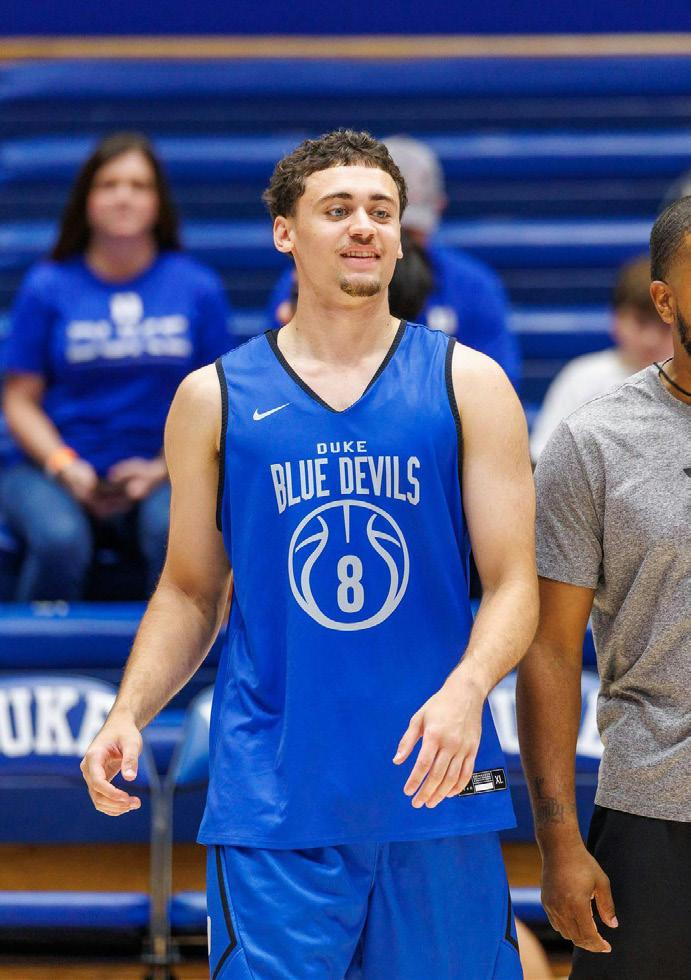

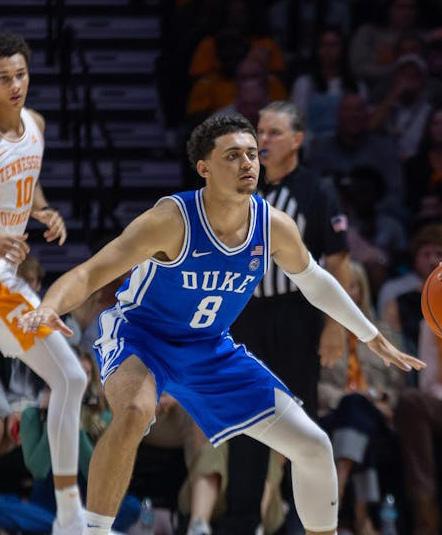
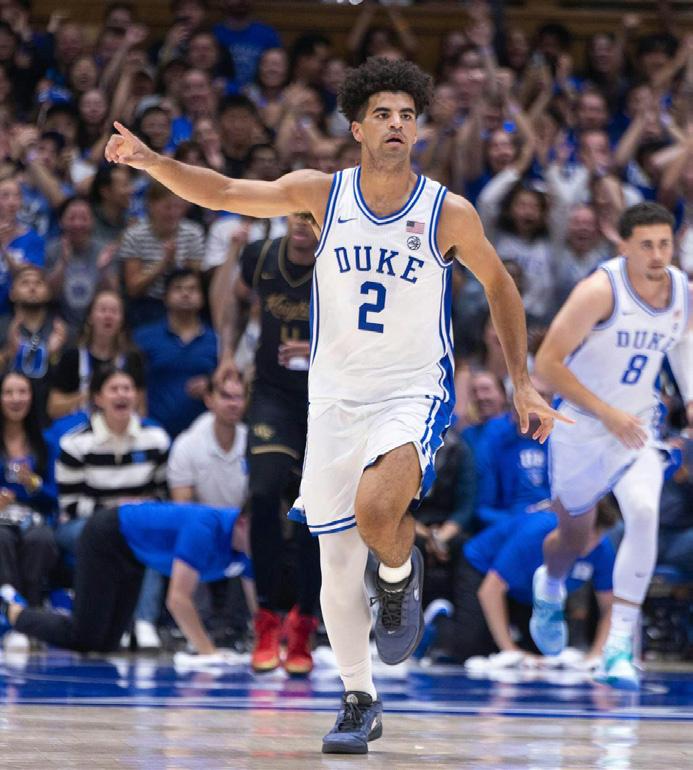

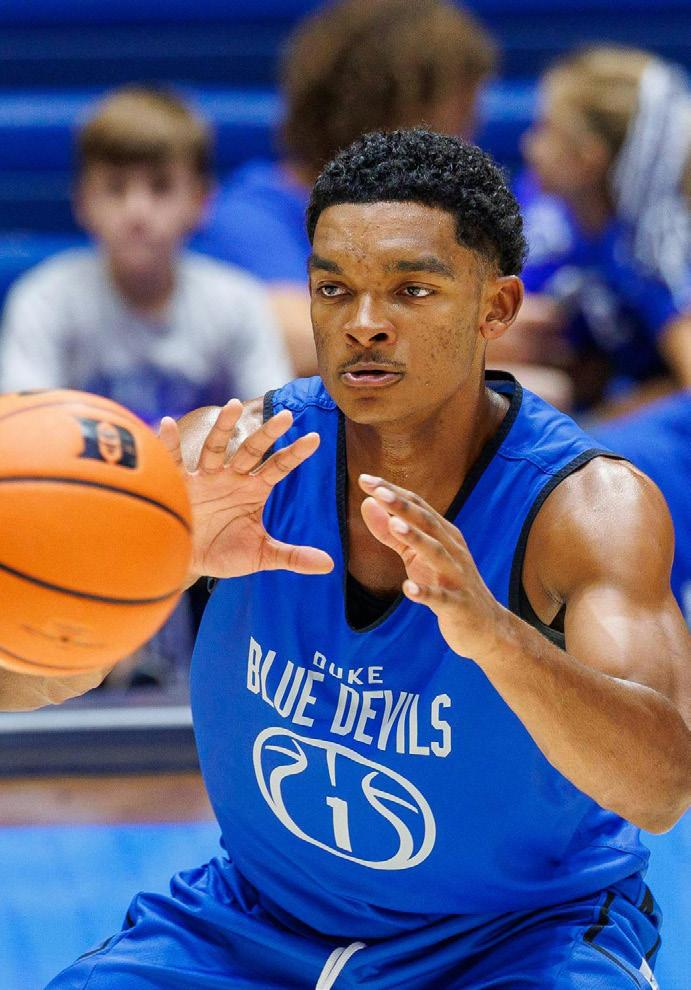
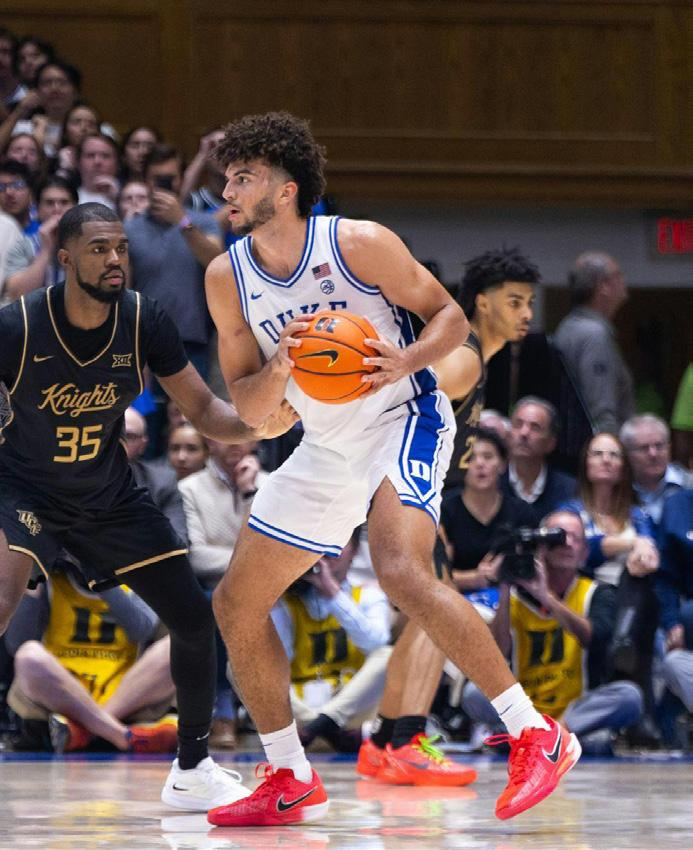
By Abby DiSalvo Sports Editor
Less than a minute remained on the clock as Carlos Boozer grabbed the final rebound of the 2001 NCAA Tournament. He and his teammates dribbled out the game to secure a 82-72 victory over Arizona, clinching Duke’s third national championship title and a coveted banner in Cameron Indoor Stadium.
Two and a half decades later, Boozer watched his son rise up beneath the very same banner, slamming a dunk through contact to score the first unofficial points of Duke’s 2025-26 season. The Cameron Crazies roared to their feet, elated to watch another legacy cement his Blue Devil promise.
But after swishing his and-one, Cameron Boozer simply sprinted back down the court, already searching for other ways to light up the scoreboard.
“I know he's thinking about all the things he could have done better,” head coach Jon Scheyer said after the game. “That’s what makes him who he is.”
The Brotherhood creates stars, but it also casts long shadows.
Shadows of the past
When Scheyer settled into his chair for the first press conference of the 2025-26 season, it took just nine minutes for the inevitable question to barrel his way.
‘What's your message to fans that want to see you back on that mountaintop, especially considering how last year ended?’
Duke’s head coach paused, if only briefly.
“I think they've seen that we're right there. Two of the last four years, we've been really close, and it's a small margin of error,” Scheyer said. “If you keep putting yourself in that position of being in that moment, being right there, it’s a matter of time before you break through, and I feel that's where our program is.”
returned,” senior Maliq Brown said. “We're all competitors, so just knowing how we left off last year … We're going to lock in.”
For Duke’s freshmen, who join the 2025-26 team in the footsteps of three AllACC Rookies, the benchmarks only pile up from there.
Two of the newest Blue Devils grew up not only with the blood of The Brotherhood in their veins, but a built-in role model on the basketball court. Cameron and Cayden Boozer watched their father achieve success in the NBA, then ran backyard drills on a bright blue concrete surface in hopes of someday following in his footsteps.
Together, the fraternal twins earned three straight Nike EYBL Peach Jam titles, four consecutive high school state championships, two FIBA gold medals and McDonald All-American honors. The hype around "The Boozers" grew louder with every accomplishment — until Cameron and Cayden entered the college recruitment process separately.
The two-time Gatorade National Player of the Year and the 2025 Chipotle Nationals All-Tournament MVP still both ended up in Duke blue.
Not because of their dad, they insist. And not because of each other.
“Me and Cameron never really talked about going to school together until, like, a week before we committed,” Cayden said Sept. 24. “Then we realized we both wanted to come here, and win a national championship here, and just have at least one or two years together, because it's the only time we're really gonna be able to choose to play with each other.”
having something you can always trust on the court,” Cayden said. “You know where they want the ball, and it makes the game a lot easier when I play with them.”
Their bond, perhaps more importantly, sparked an insatiable competitive fire.
“First and foremost, I'm a winner,” Cameron said with a sly smile. “I feel like that's why you recruit me, to come here and win. That's what me and my brother have done our whole high school career.”
Shadows of self
Duke’s veterans find shadows in themselves. Look no further than Foster, who has dedicated the past two offseasons to attacking his weaknesses. After fracturing his ankle as a freshman, the junior point guard never quite rebounded. Pressure lingered.
“They make it easy for you to run away, because you can just go to the next place,” associate head coach Chris Carrawell said Sept. 24. “For him to stick it through says a lot about his character. He's an old-school guy, takes the old-school approach. Just doesn't run.”
Foster, Patrick Ngongba II and Isaiah Evans worked swimming into their workout plans to improve cardio. Foster improved his voice on the court while hosting The Brotherhood Podcast. Even when the opportunity to transfer presented itself, he stayed focused on the Blue Devils.
It's either glory or it's heartbreak. To me, there's no in-between. See
JON SCHEYER HEAD COACH
College basketball fans love nothing more than comparison. Though Scheyer starts each season with a brand new iteration of Blue Devils, the Duke faithful will never stop measuring them against one another.
“It's either glory or it's heartbreak. To me, there's no in between,” Scheyer said. “Unfortunately for us, last year was heartbreak. Most years, it's heartbreak.”
Last season’s Blue Devils topped the charts in nearly every statistical category, losing only two of the 26 games they played after the new year. The team advanced to a Final Four before bidding farewell to five stars in the 2025 NBA Draft. Duke’s 2025-26 season begins in the shadow of that brush with glory, and some veterans wish the ghosts of the past would leave their new contingent alone.
“It's just a whole different team, different play style. We can learn some stuff, but we just got to create our own identity,” guard Caleb Foster said Sept. 24. “We're not really looking at the two last years on our journey.”
Others find motivation in the unfulfilled promise.
“We still have a chip on our shoulder, from how it ended last year, just the guys that
They succeed their father — whose 0.627 field goal percentage at Duke still ranks third all-time — but have different impacts on the court. Cameron takes formidable command of his own shotmaking, crashing the glass at every opportunity. Cayden fills the point guard role with dynamic reads and an impeccable eye for open passing lanes.
They shrug off comparisons to The Brotherhood’s original Boozer, despite shadows of similarity. His memories of Duke basketball take on a different gloss.
“The stories my dad told me were just about how [Mike Krzyzewski] used to get on him and make sure that he was the best player he could possibly be,” Cayden said. “But, I mean, I feel like those are kind of the same, because Coach Scheyer is always on us and wants us to be the best we can possibly be.”
The twins look to outpace their nationalchampionship-winning father, but they must also reckon with a mirror image on the court. No. 2 and No. 12 have pushed each other since they were old enough to make a free throw.
“Being able to play with my brothers helped me a lot playing basketball, just


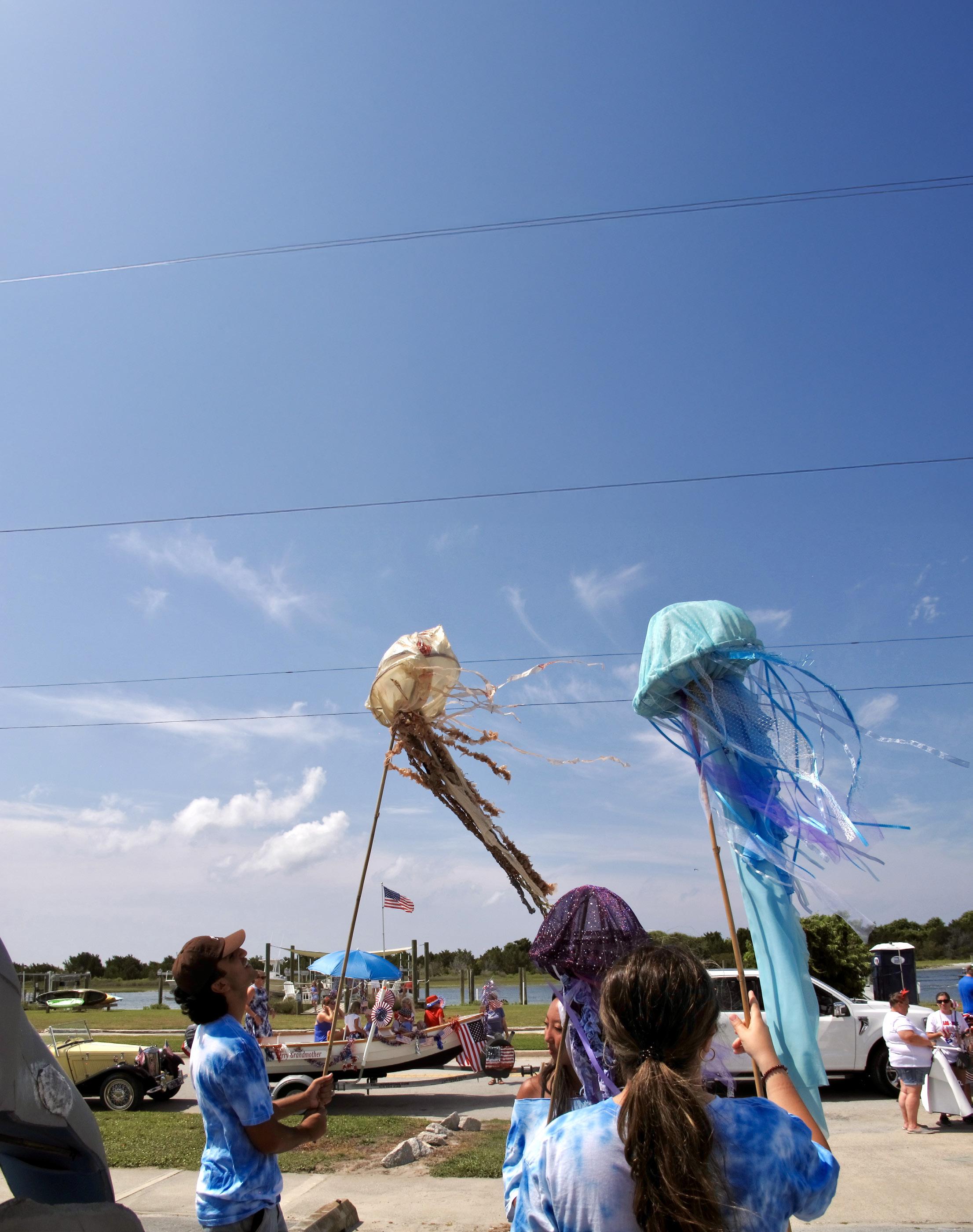
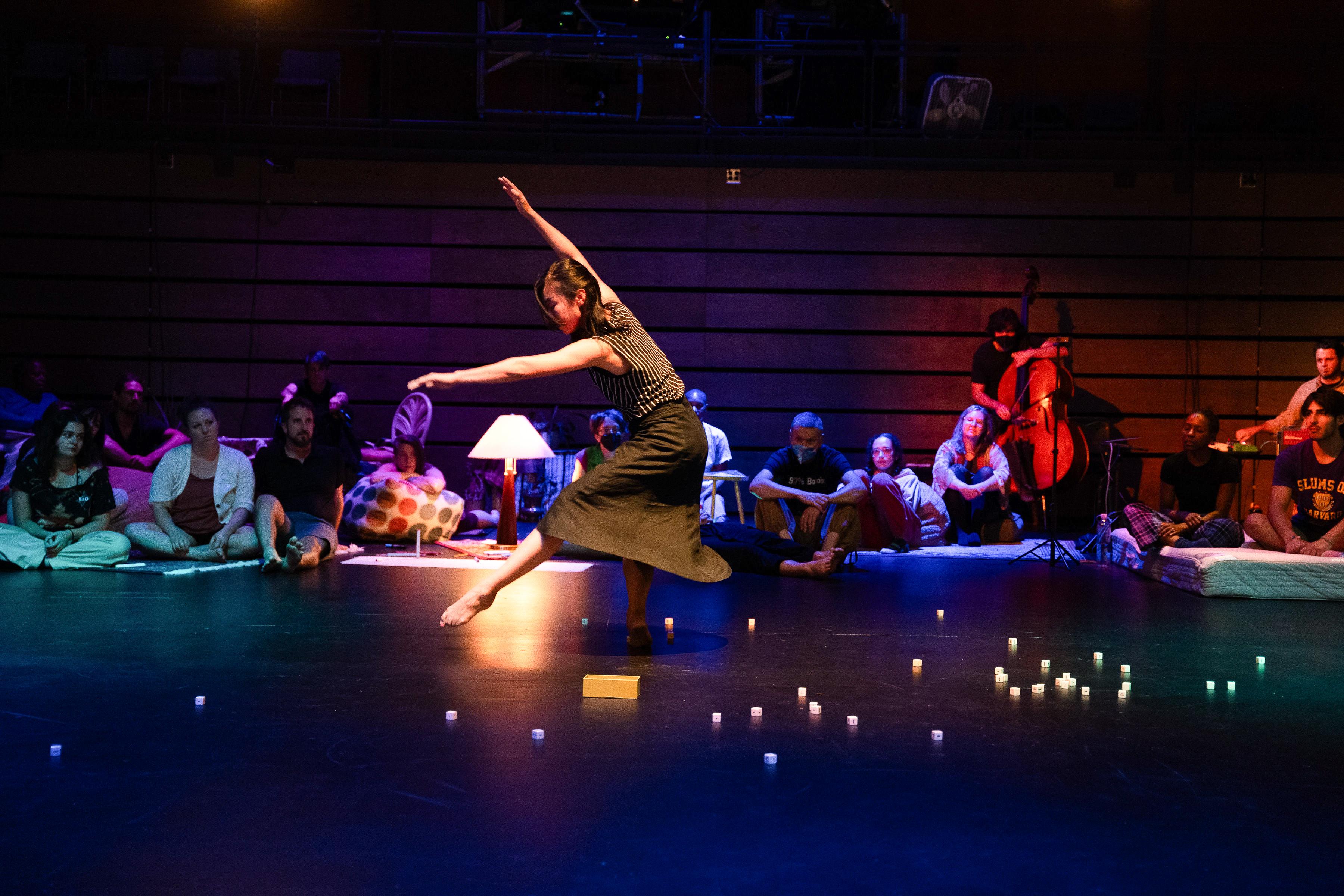
By Alex Min Assistant Blue Zone Editor
The threes rained down early for the Blue Devils.
After a long seven months since its last contest in Durham, Duke returned to Cameron Indoor Stadium for an exhibition clash with UCF. By the first media timeout, sophomore Isaiah Evans had already connected on two of his four attempts from beyond the arc, while classmate Darren Harris barely moved the net on a left-corner three. Minutes later, Cameron Boozer knocked down another from the opposite corner. Of Duke’s first 10 field-goal attempts, nine came from deep.
Though their 3-point fire would waver as the contest went on, the Blue Devils surged ahead in the second half of the Brotherhood Run contest for a 96-71 victory over the Knights.
"There's a lot we have to get better at, but I did like the competitiveness," head coach Jon Scheyer said. "I did like the fire that we showed. And we may not be deep in terms of numbers, but I think our depth is in our versatility with the different lineups we can play."
Following a string of empty possessions to open the game, center Patrick Ngongba II stood at the elbow and found an open Cameron Boozer in the paint. The freshman didn’t hesitate, elevating to flush the ball over his defender for an emphatic and-one dunk.
On the other end of the floor, Scheyer’s squad played fast and physical. The Blue Devils jumped for every loose ball and invaded every passing lane. When opposing forward Riley Kugel lost his dribble, Cameron Boozer dove to the hardwood — wrestling for control with the Knight. Although Kugel regained control, he fired a hurried pass to a teammate behind halfcourt: Duke ball.
However, UCF refused to relinquish the game early and nailed three straight attempts from distance. With the lead back to within single-digits, the Blue Devils needed a response.
Two possessions later, Cameron Boozer led the charge. Receiving a pass at the top of the 3-point line, the freshman collected himself before knocking down his second long-ball of the contest to give the Blue Devils a 26-20 edge. In his college debut, Boozer needed no time to get acclimated to his surroundings. The forward finished the contest with 33 points, 12 rebounds and four assists on 12-of-19 shooting.
"He's a warrior. I think that's the best thing I can say about him." Scheyer said regarding Boozer. "I thought he was a high-level player, as good as he gets tonight. And I know there's even more there we can help him with — that's the great part about him. I know he's thinking about all the things he could have done better. That's what makes him who he is."
While Duke struggled from the field, it was opportunistic in its offensive rebounding — keeping the team from falling behind to
the visitors’ hot shooting. By the end of the half, the team from Durham had collected 11 offensive boards.
UCF didn’t need extra possessions. As a bruising defense forced erratic attempts around the rim, the offense found its rhythm. Once down by as much as 11 points, the Knights crawled back to regain the lead on a soft turnaround jumper by forward Jamichael Stillwell. Moments later, Kugel took a defensive rebound coast to coast — contorting mid-air to
convert on the fast break. The scoreboard read 34-30 in UCF’s favor as
The Blue Devils had gone ice-cold from the field, but especially from beyond the arc — failing to connect on four consecutive shots. Evans, however, didn’t get the memo. In an almost exact replica of his first made attempt, the Fayetteville, N.C., native calmly rose up
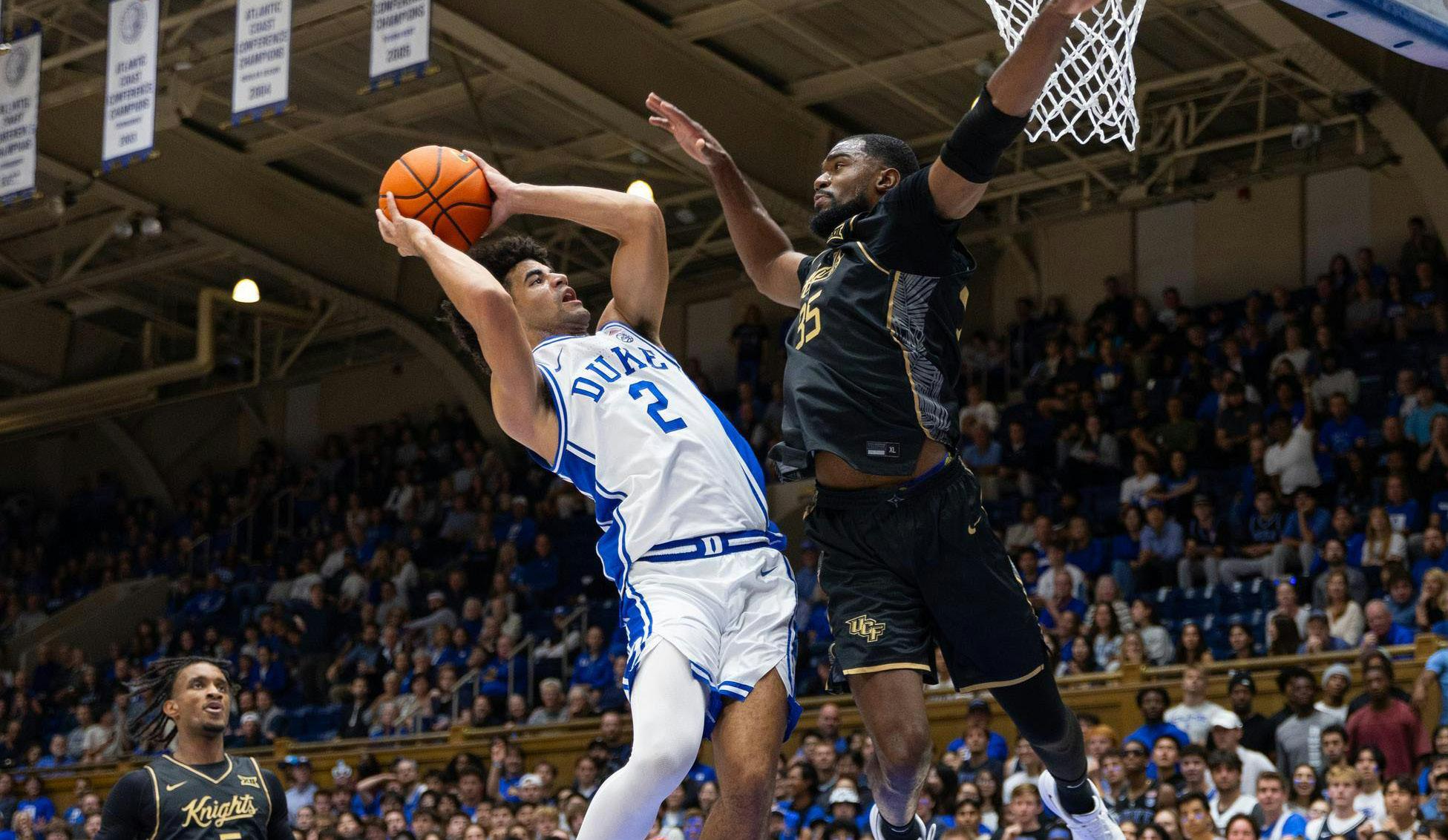





By Sophie Levenson
Senior Editor
In Duke’s first exhibition game of the season, against UCF in Cameron Indoor, Darren Harris fell, more than once, to the floor. With each knock down onto Coach K Court, a blonde woman sitting a few rows behind Duke’s bench shot up out of her seat. Shorter than most other basketball parents, Roxy Harris craned her neck to get a clear view of her son.
Darren was fine. But his mother had reason to worry: In the first week of his freshman year at Duke, he broke his wrist. It was terrible. His first week of college after years of working his way into this program, and he couldn’t play basketball.
Roxy stood each time because she knew she would be able to tell if Darren had been hurt based on his face when he fell. She’s a mother. Would she be able to reach him, if he had been? With the athletic trainers and managers and coaches between her and her son — not to mention the fact that she can’t just run onto the court in the middle of a game — probably not. Would she want to? Of course. But as a mother, Roxy is used to holding back.
Every mother makes sacrifices. The things she must give up start to tally even before her child is born: Her body, her time, her energy. Like anyone else, a Duke basketball player
does not come out of nowhere. Someone drives him to practice, pays his AAU fees, cooks his dinner, misses work functions, skips vacations and talks to the doctors when he’s hurt. Someone who wants to cry puts on a smile; someone accustomed to saying what’s on her mind bites her tongue.
One look into her piercing blue eyes — Darren’s are just a shade brighter — can tell you Roxy Harris is not someone you want on your bad side. This is a tough woman. A self-identified trash-talker. She played college basketball, so she’s a fierce competitor. She coached youth league basketball, so she can handle insanity. And she had Darren when she was 20 years old, which makes her a force of nature.
Roxy used to pelt Darren with questions and lessons following his games. After Tuesday’s, she wanted to ask him, “Why did you go under the screen and foul on the three?,” but she held back. Now, she’s a cheerleader, all “rah-rah,” trying to keep a smile on her face no matter what she might be thinking. She even intervenes when her husband, Kevin (a high-school basketball coach), starts to run through the list of things Darren did wrong, abruptly picking fights with him to change the subject and give Darren his out.
“You didn’t do the dishes yesterday!” she’ll shout at Kevin, winking at her son.
“My parents did a good job figuring out the balance between when they need to get on me, be hard on me, and when I need some support,” Darren said. “It’s her first time being a mom, too.”
Tajama Ngongba has the rod-straight posture of a politician. Tuesday night, she sat up straight on her seat in the parents’ section of Cameron Indoor, her neat bob a shiny foil to Roxy’s messy bun. Her cross-body bag suited her sweater, and a silver cross necklace gleamed at her throat. She’s poised, but, like her old friend (Darren and Patrick went to high school together), she demands respect.
It's her first time being a mom, too.
Roxy and Tajama have learned that Darren and Patrick aren’t looking for criticism or advice from their parents after each game; that’s what their coaches are for. Maybe later on, after the frustration of a bad performance has subsided, Patrick will ask his mother what she thought he did right and wrong or Darren will be open to hearing what Roxy noticed. But in those moments of emotion, whether characterized by frustration or celebration, the boys want their mothers to be just that — moms.
DARREN HARRIS DUKE BASKETBALL SOPHOMORE
This is a woman who once took shelter in a refrigerator with her parents and siblings to survive a hurricane. As a player at George Washington, she was named an All-American and the 1997 Atlantic 10 Player of the Year. She was the head coach of Radford’s women's basketball team, an assistant coach at George Mason and an assistant coach at George Washington. Now, she coaches the U.S. Virgin Islands’ national women’s basketball team.
In other words, Tajama has earned the right to an opinion on basketball. And she usually has one. But like Roxy, Tajama keeps it to herself.
“Someone told me there's nothing more appropriate you can say to your kid than just, ‘I love watching you play,’” Tajama said. She tries to remember that in moments when her instincts as an Olympic gold-winning basketball coach itch to come out. “Say something that's positive,” she tells herself. “Be mom, not coach, mom, not anything else. Just be mom, be supportive. Just be encouraging.”
‘Pouring into them’
Several of Roxy’s coworkers think she’s crazy because her life revolves around the travel plans of a college basketball team. But until Darren leaves this program, his mother’s calendar will look like the “Schedule” tab on GoDuke.



Marieke Lemon, Isaiah Evans’ mother, raised her two sons by herself. When Isaiah’s basketball career took off, everything else became less important: vacations, romance, sleep. Marieke didn't date anyone for four years; she didn’t have the time. She had to build a work schedule that simultaneously supported her family and allowed her the flexibility to cheer on Isaiah at his basketball games. Sometimes, Marieke would pick up weekend shifts for her job as a quality assurance manager. Then she’d sneak out of the office to take her lunch break at a highschool gym.
In return for the sacrifices she made, Marieke asked Isaiah to earn a full ride to college. It wasn’t a problem for him. The Lemon-Evans family took their first vacation in six years when Isaiah was a senior in high school.
To be a basketball mom commands a serious time commitment. That much is obvious to anyone who has ever looked at the family section of Cameron Indoor and seen the same faces every week. What’s harder to see from the bleachers is the emotional investment the job demands.
When Darren had surgery on his wrist last year, his mother fought to hold it together. As soon as the doctor put in the nerve block, Roxy burst into tears. She had to leave the room and compose herself to appear calm in front of Darren.
When Patrick underwent surgery his senior year of high school — and had to miss the playoffs — his mother retreated to another room and prayed. Then she turned on her smile, went back to Patrick and told him it would be okay.
Prayer carries Tajama through many challenges: Mothers need to take time for themselves, and for Tajama, that often means finding moments to pray or seeking advice from other parents.
“There's a certain place you have to be mentally, as a parent, to carry somebody,” Tajama said. “You’ve got to fill your cup up first before you can start pouring in to them.”
And pour she did. For the Harris and Ngongba families, raising a future Duke basketball player demanded more than a financial commitment. Roxy and Tajama both spent hours in the gym with their teenage sons, drilling them on fundamentals: in Tajama’s case, after doing the same thing all day for her coaching job; in Roxy’s, after nine hours at an accounting firm. They’d have to run like they were 20 years younger than they were, and then take flack from those snarky teenagers if their passes weren’t up to par.
groups, to talk. After a comfortable home win like the one against UCF, the room buzzed with laughter and felt like a family reunion.
That room, or Duke’s team bus, for the road, wasn’t often quiet during the 2024-25 season. There was something magical going on in The Brotherhood, a shared confidence that everything had come together, a constant cause for celebration. Traveling between Durham and college towns all over the country, the moms got to know each other. They grew close, largely because, according to Roxy, there was none of the spite or cutthroat behavior that parents of elite basketball players often breed.
“Everyone kind of bought into where we were and how incredible our team was,” Roxy said, sitting in one of those Cragg Family Room booths.
“I just think the group itself was good people,” Tajama added, nodding at her friend. “What made these moms so special was that you knew they had anybody’s son’s back. It didn't matter — most playing time, least playing time — it didn't matter where you fell. You were as important, and every mom felt that.”
Maliq Brown’s mother couldn’t make the UCF game, so her friends in Cameron Indoor made sure Brown felt the love of other team moms in her place. When the team’s parents take their seats behind Duke’s bench, it’s not just for their kids, but also for each other. Even now, as the Duke basketball world shifts its focus to the 2025–26 season, many of last season’s moms keep in touch. Roxy talks frequently to Kelly Flagg and Tammy McCall (Mason Gillis’ mother). After all, they watched one of Duke basketball’s best years arm-in-arm.
And they got through one of its hardest days together, too.
The team bus was silent the evening of April 5.
When the clock hit zero and Duke’s semifinal game against Houston ended — in a startling loss that’s still hard to digest — Tajama, Roxy and Marieke sat in the stands and longed to be on the court with their sons.
“I cannot get to my kid. I want to get my kid. I want to hold him. I want to hug him,” Marieke recalled thinking.
Hours passed as the players’ families tried to avoid the throngs of Duke fans also staying in that downtown San Antonio hotel. Strangers approached them and tried awkward condolences. “Please don’t talk to me,” Marieke thought to herself.
There's a certain place you have to be mentally, as a parent, to carry somebody.
Raising a basketball player meant Tajama Googling “recovery pants” on the internet as she looked for every way to make Patrick’s life easier. She drew epsom salt baths and massaged the knots out of her son’s back with her own tired hands.
“She’s the best mom,” Patrick said.
The Motherhood Family photos line the bookshelves in the Cragg Family Room. After every home game, players’ parents and siblings wait for press conferences to end in a brightly-lit room lined with booths and couches, just down the hall from the men’s locker room. The fathers pick at snacks in the back, younger brothers and sisters challenge each other in table tennis and the mothers slide into booths, or stand in
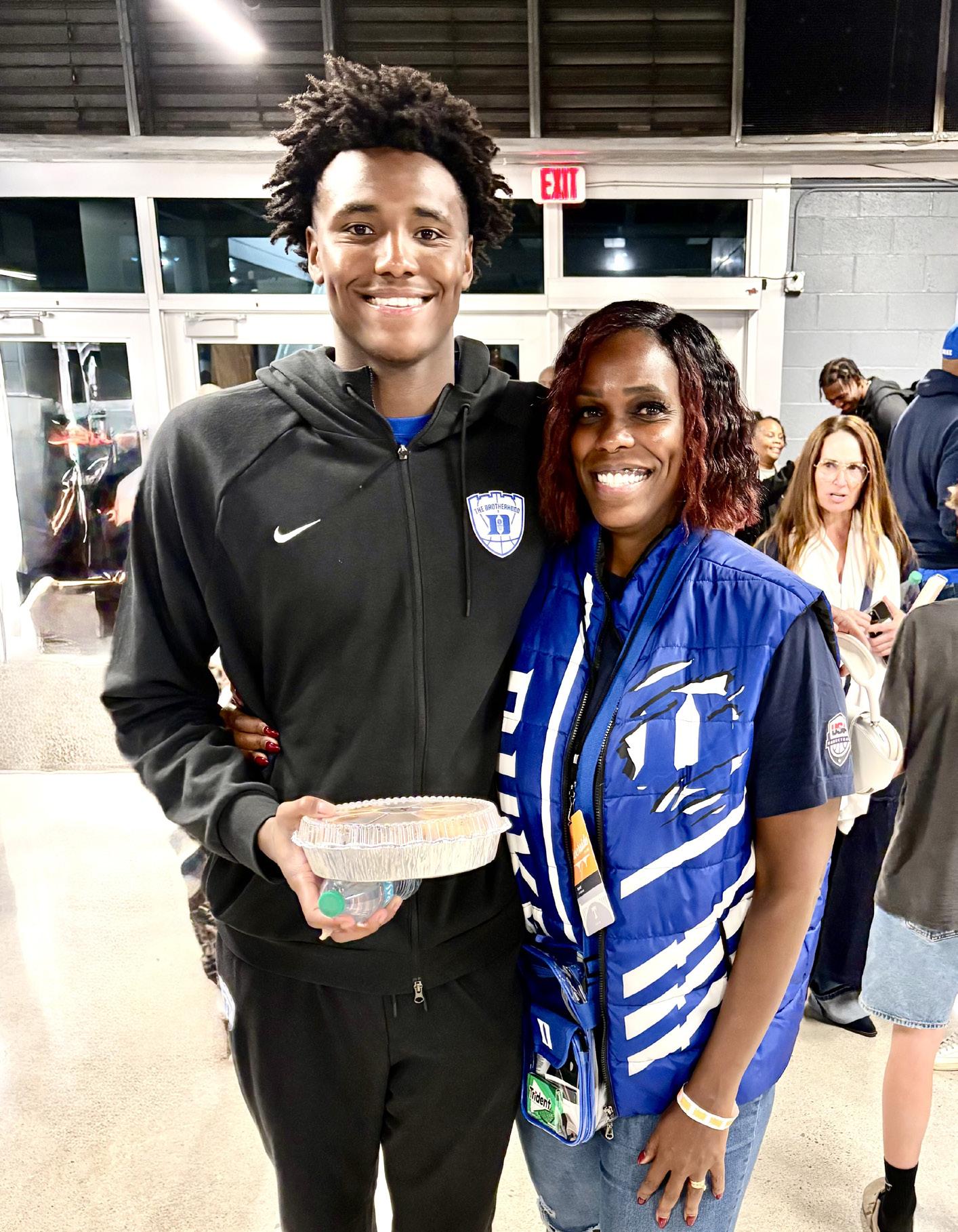
With the other mothers, she didn’t need words.
Back in the hotel, in a makeshift family room, the moms huddled together.
Like a basketball team on a time out, they bent their heads and circled up. Then they cried. Not for the loss, but for the hurt that each mother felt for her son and, in turn, for the other women in the circle. Mothers will tell you they’re only ever as happy as their unhappiest child. Imagine what that means for a mom whose son has just lost out on a national championship.
“As a mom, I know how heavy they are feeling for their boys,” Tajama said.
“These women can understand where we are and who we are,” Roxy said.
So on that fateful April night, Duke basketball’s moms draped their arms around the only people who felt exactly the same way. And they cried; for once, letting it all out.


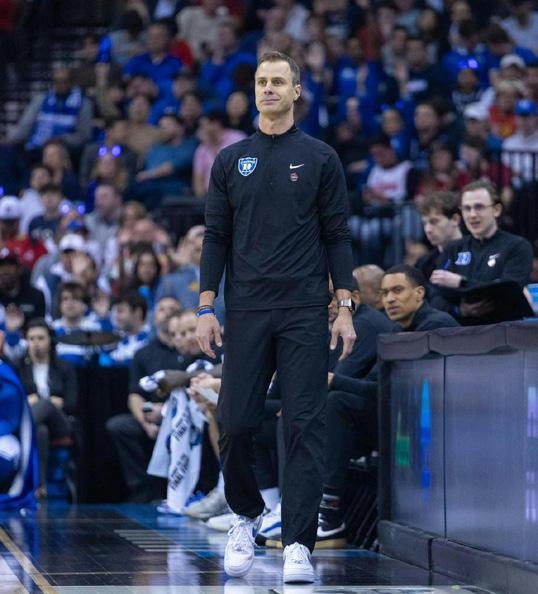
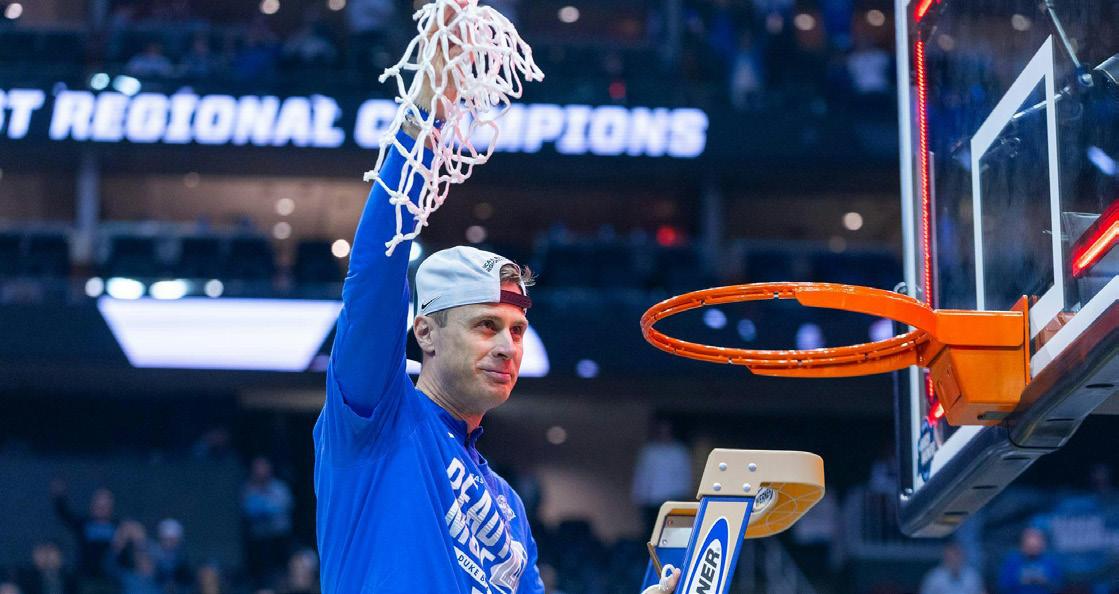
By Dom Fenoglio Senior Editor
It only takes a few minutes of watching highlights from Jon Scheyer’s playing career to realize his potential as a future coach. The four-year Duke point guard excelled at making reads, finding space and locking in for crunch time.
It takes even less time watching the current Blue Devils on the court to recognize their play-caller’s past as a premier hooper.
As he has matured over the past three seasons as Duke’s head coach, Scheyer has molded the program into his own. One trait that stands above all else is his willingness to put the power in the hands of his players. The Blue Devils’ offensive
scheme is not based in complicated sets, nor is its defense reliant on traps or heavy pressure. Instead, Scheyer coaches his teams to win by equipping them with elite decision-making tools that bolster their inherent talent.
It has taken time for Scheyer to grow out of legendary head coach Mike Krzyzewski’s shadow and into a renowned coach of his own right. In his first year at the helm, Duke averaged just 72 points per game, and in the team’s nine losses that season, it only eclipsed 70 points once. While the Blue Devils certainly had offensive talent, a significant number of buckets came from isolation spots. That plagued Duke against the ultra-physical Tennessee in the second round of March
Madness, Scheyer’s earliest exit thus far in his career.
However, the 2022-23 season still laid the foundation for what was to come. Fans will fondly remember Jeremy Roach’s link-ups with Dereck Lively II to take down North Carolina at home, and Kyle Filipowski’s big-time showing in the ACC Tournament gave the Blue Devils a banner to hang. While spottier than future seasons, at its best, Duke displayed a cohesion on offense reminiscent of Scheyer’s peak as a point guard.
Taking a look at the Blue Devils of this past season — who finished with the highest offensive efficiency margin in the country per KenPom — it’s easy to see that same offensive flow turn into a


downpour. One of Scheyer’s go-to plays relied entirely on both Kon Knueppel and Cooper Flagg reading what the defense gave them.
Often, one of the talented freshmen would catch the ball around the freethrow line off a short roll. With their primary defender on their hip, the ballhandler was free to drive to the paint and force the opponent into a mistake. If the center helped, Khaman Maluach leaped for a lob. If a wing came from the corner, one of countless shooters had an open look. If everyone stayed home, Knueppel and Flagg would feast for a bucket of their own. If that sounds too easy, it’s because it was — at least, it was for two top-five NBA draft picks.

It is unreasonable for Scheyer to expect such an elite level of talent on an annual basis, but the concepts Duke aspires to are hardly unattainable.
For example, Scheyer will utilize off-ball screens to free up shooters in space. If the primary defender tries to trail his man directly and fight through the screen, the shooter has a window to shoot. If he tries to switch coverages with his teammate, the screener cuts to the basket for a lob or post-up. This is a play run with success at the high-school level; the talent the Blue Devils possess just makes it nearly impossible to guard when executed correctly.
These strategies helped Scheyer maintain an elite shooting presence with Isaiah Evans after the departure of Jared McCain to the NBA. McCain had a better handle on his dribble than Evans did as a rookie, which allowed Scheyer to keep the offense open and let McCain thrive naturally — to the tune of 87 made triples. It took Scheyer a few games to bring a similar level of production out of Evans, but his barrage of 3-pointers in Duke’s early-season win over Auburn was a testament to both player and coach.
Both of Evans’ first two deep balls came off a down-screen action. The Blue Devils had a pair of shooters receive screens on either side of the court, giving Evans just enough space to get off his quick release. What followed was a ridiculous display of talent and confidence, as the then-freshman totaled six 3-pointers in the first half. Scheyer also deserves credit, having put
the 6-foot-6 flamethrower in situations where all he needed to do was let it fly.
What makes Scheyer’s coaching all the more impressive is the abbreviated timeline in which he teaches these concepts to mastery. He has coached just one rotational player for three years — Tyrese Proctor — and the majority of team members left after one year, either to the NBA draft or the transfer portal. So, Scheyer is forced to essentially start over annually. While that complicates the process, it also allows him to improve his coaching strategies in real time.
Considering Duke’s offensive strategy under Scheyer, it is no surprise that the defensive scheme also has few bells and whistles. An elite recruiter, Scheyer has made it clear that size is at the top of his list, with teams seemingly getting larger and larger throughout his tenure. This season, the starting lineup may feature three players 6-foot-8 or taller.
Long arms and leaping ability do not immediately translate to defensive dominance, however, and the jump in physicality between high school and college basketball affects many young players at the beginning of their careers. Scheyer has done an impressive job developing defenders in the frontcourt — both Lively and Maluach were selected in the first round largely because of their rim protection — but his work helping guards become elite on the perimeter deserves just as much praise.
A perfect case study is Proctor, who was the Blue Devils’ lightest player — besides walk-on Spencer Hubbard — his freshman season, but grew into one of
the team’s strongest on-ball defenders by his junior year. Proctor’s numbers speak for themselves: He totaled just 22 steals in each of his first two seasons, but jumped to 31 in his third year. The change was more than maturity, as it was clear last season that the Sydney native had a level of comfort in Scheyer’s system that allowed him to read plays before they happened.
At times during the early parts of his career, Proctor set up out of position and got caught trailing his man or switching onto a bigger player in the paint. Scheyer is fine with the latter, as he tends to switch players one-through-five. In order for this move to be effective, though, guards need to maintain a relative advantage when switched onto forwards. For example, it is much easier for a smaller player to make up the difference when a big man is caught in the corner of the court or outside the 3-point arc. This only happens when the defense can funnel opponents into these zones, which requires a knowledge of what the offense is trying to do.
The easiest way for defenses to build this intuition is experience, a commodity that has become increasingly valuable with the advent of the transfer portal. Scheyer has consistently recruited veteran defenders to supplement his teams — Syracuse transfer Maliq Brown epitomizes great defense — but just as with his offense, the coach has shown a remarkable ability to teach freshmen how to anticipate on defense rapidly.
Of course, no season is without its bumps, and Scheyer has not been
immune to such mistakes. In early season losses — including those to Kentucky, Arizona and Kansas in each of the last three campaigns, respectively — it is easy to see the faults of a Duke team still going through growing pains. And while Scheyer’s empowerment of his players has led to two ACC championships and six first-round picks in just three years, each of the Blue Devils’ NCAA Tournament exits have come after an opponent was able to rattle Duke and take advantage of subpar decision-making.
A trademark of the Blue Devils’ playing style is the tendency to go on massive scoring runs. The tradeoff to Scheyer’s coaching style kicks in when the snowball starts rolling the other direction. Without an abundance of set plays and defensive tricks to fall back on, Duke can make a bad series worse when its shots aren’t falling.
Still, Scheyer’s bet is that talent will win out, and he has largely been proven right. A competitor at heart, he coaches the Blue Devils to have the confidence to believe they are capable of beating anyone and everyone. While he is still looking to prove his claim with a national championship title, it is not hard to imagine the young head coach hoisting the same trophy he did as a player.

FROM PAGE 8
their mental fortitude and controlling what they can control on and off the court.
“I think the thing that messes players up the most is missing shots, turnovers,” Scheyer said. “And the reality is, if you’re not in the right gap position, or if you don’t rotate and give up a three, that’s the same value of making a three.”
From a player development perspective, the staff has to understand individualized coaching and what a player’s mindset needs on any given day. For McCain, that might be tailoring a workout “just to get someone’s confidence built up.”
Taking coaching is one of the more underappreciated skills in players, and Duke’s recruiting staff prioritizes humility from the beginning.
“For them to come here to us as freshmen or sophomores and being told that they’re doing things wrong is a little new for a lot of these guys,” assistant coach Emanuel Dildy said.
“They come in with an incredible attitude every single day, where they attack the day, whether it's in the weight room or on the
FROM PAGE 11
“I had to self-reflect, look myself in the mirror,” Foster said. “A lot of things were in my control that I thought I could get better at, and obviously just got to keep fighting. That's what makes good Duke players: people who fight with resilience.”
His contributions never piled up on the stat sheet, but those around the team spoke to his improvement.
“He can score and impact with the ball, but the areas without the ball are where I've seen a ton of growth,” Scheyer said. “That shows maturity, and it shows how coachable he is and how badly he wants to win a national championship.”
Evans was another player who had the opportunity to leave after the heartbreak in March. Rather than declare for the NBA draft or abandon ship for N.C. State — as many rumored he might do — the fiery sharpshooter returned to Cameron Indoor for his sophomore season.
He had increased his production and minutes in the final month of the regular season before hitting a wall in the NCAA Tournament. Now, as a team veteran and likely starter, he itches to find the net again.
“I can't wait to just start playing,” Evans said Sept. 24. "I’ve just been waiting all summer. Now, the days are finally ticking down, and it's going to be a reality soon.”
For Brown, who transferred to Duke last season only to battle a jumble of injuries, an appearance on the court will have to wait a little longer. The 2024-25 campaign saw the defensive standout sidelined twice with a dislocated shoulder and various toe and ankle issues. Though Brown rehabbed them all, he underwent a precautionary knee scope in the offseason and will miss the first few games of the year.
“It’s definitely been difficult,” Brown said. “I was just watching my brothers play … [and] I wasn't able to get on the court and run with them. Seeing them fight through conditioning and the different drills and competition games was definitely something that was bothering me.”
Duke’s senior big man faces high expectations of his own when he returns to the floor. The player Scheyer once described as a “defensive menace” will once again take over as the backbone of a team known for stifling frontcourt disruptions. Matching or exceeding production will be key to maintaining that legacy, but he isn’t the only one with a bar to raise.
court,” Bradds said. “These guys also want to learn why they're doing what we’re asking them to do. And I think that's incredible, that they want to expand their minds as well as their own core abilities.”
This summer, all of Scheyer’s returners had their own personal development blueprints. Sophomore Darren Harris cut out fried foods and sweets to improve his physical fitness. Patrick Ngongba II also partook in the fitness journey by losing 16 pounds. Sharpshooter Isaiah Evans, now circled on scouting reports as a threat from deep, has worked on his physicality on the defensive end to match up with the toughest guards in the country, part of his 98%. And Maliq Brown and Caleb Foster, Duke’s two representatives at ACC Tipoff in Charlotte, have developed their vocal leadership to mentor the emerging freshmen.
The ultimate goal for a majority of the Blue Devils' players is to play professionally. And the new coaching hires from Scheyer and intentional focus on physical and mental development ensures that the path through Duke best prepares them moving forward while also forming a cohesive unit designed to succeed at the college level.
Shadows of the future
Come March, Duke men’s basketball will have gone a decade without a national championship — the longest drought since the program won its initial title. Forty years will have passed since Krzyzewski made his first Final Four. The five banners hanging inside Cameron Indoor Stadium will once again beckon for an addition.
Scheyer won’t rest until he hangs one.
“He’s adapting,” Foster said at ACC Tipoff. “I just see how much he dedicates to the craft, and how much time it takes for him to get ready and prepare for us and different game plans, different schemes, offensively and defensively … and I really admire that.”
For all the lessons that linger in the past, it’s the unsolvable equation of the future that keeps Scheyer up at night. He assembled a gauntlet of a nonconference schedule and invested heavily in player development while searching for the keys to unlock the next level.
“There's no limit on what we can do. I think it's a matter of just putting it all together,” Scheyer said. “I think it's about this year, what we're doing and how to be the best version of maxing this team out.”
Fans have a high floor of expectations, as do the recruits and the veterans. Scheyer has noticed. The young Blue Devils came in fighting to establish their place on the court. The older players set a tone for the season. They practice each day with an endgame of winning the endgame.
“I've seen great hunger, which is what gives me great confidence for this team,” Scheyer said at ACC Tipoff.
At the first press conference of the year, the players mentioned a national title four times. Even slow starts in two exhibition games couldn’t waver their confidence — against Tennessee, Cameron Boozer turned in a 24-point, 23-rebound performance while Evans and Ngongba both put up career-high point totals. The team wants to keep climbing from there.
“I think the goal every time, anytime you're at Duke, is to win a national championship. And our team isn't going to settle for anything less,” Cayden Boozer said. These Blue Devils aim to cast shadows of their own.
FROM PAGE 13
from the left wing and drilled his third 3-pointer of the half.
After a wild and frenetic 20 minutes of play, Duke led by a single point.
But the second half promised to be a battle, and out of the break, the Knights returned swinging. On the away team’s opening possession, guard Themus Fulks found the bottom of the net from beyond the arc — swiftly recapturing the lead. Meanwhile, the UCF defense refused to allow an uncontested layup; when Blue Devils probed the paint, the visitors swarmed, poking and swatting at the ball.
Cameron Boozer responded to the upped physicality instantly. The Miami native put his head down as he drove to the rim from the left. Using his size, the forward fought through defenders and converted the layup through contact. Boozer wasn’t done; as Duke traveled back down the court, he launched another open look behind the 3-point line. The attempt rattled around the rim briefly, but when it found
FROM PAGE 9
David Rebibo told The Chronicle. “I think Nik was able to connect with that once he felt the connection of the coaching staff and saw the vision.”
Scheyer and former head coach Mike Krzyzewski have also never shied away from dipping overseas to secure the best talent. Starting with Luol Deng in 2003, Duke has had 10 rotation players with international backgrounds suit up on the hardwood. Of that group, just four came directly from another country instead of first playing at the American high school level — a relatively common trend with talented young hoopers. The only nation with multiple global Blue Devils? South Sudan.
Now, Scheyer welcomes Italian and Senegalese freshman Dame Sarr, who becomes the first Duke freshman to have played professional basketball before taking the court in Durham. The young wing has been with FC Barcelona since 2022 and now heads to the U.S. to pursue new opportunities.
“Economically, it’s simply incomparable — staying in Europe cannot compete with what young players can receive through NIL in the U.S. This financial factor has
nylon, Boozer, his teammates and the Cameron Crazies roared thunderously. The Blue Devils had inched ahead to a 54-48 advantage. Scheyer’s team had regained momentum — and its confidence.
As Knights forward Jordan Burks elevated to attempt a layup, Evans raced to the paint and engulfed the shot entirely. In a flash, the guard was at the other end of the floor — converting the transition opportunity at full speed. With a little over nine minutes remaining in the contest, Harris cut across the floor and found an unguarded Nikolas Khamenia in the right corner. The freshman, unbothered by his 0-for-4 line from deep, sent the ball through the net to become the fourth Duke player in double-digit scoring.
A 3-pointer by Burks kept UCF within striking distance, but the Blue Devils kept their cool. Junior Caleb Foster pump-faked a defender, took a dribble and made a three, his first field goal of the contest. With the home squad rediscovering its shooting stroke, the deficit soon reached an unmanageable margin for the Knights.
completely shifted the balance toward developing in the American college system,” Alex Terés, technical director for youth basketball at FC Barcelona, wrote to The Chronicle. “That said, it’s also undeniable that the quality of competition, the experience and the exposure that the college system offers are, by themselves, very attractive today.”
Sarr almost certainly won’t be the last to head to Durham, as recruiting European pros has become the new hyperfixation of coaches around the country.
“That was a big priority for me, and something even in the transition Coach K and I talked about ... But going forward, it's a new wave,” Scheyer said. “Everybody's gonna be looking at it and seeing how it all translates is interesting. I think there's an adjustment period, but the level of competition, the experience, no question that's valuable.”
While the data differs from year to year, it’s clear that Duke is not willing to leave any stone unturned when it comes to building the best roster possible. With the rapidly changing landscape of college basketball, there’s no telling what the next big trend will be in terms of roster construction. But one thing is for certain: Scheyer won’t hesitate to make any connection needed to construct a championship roster.

Packed with events and things to do to keep your calendar full and your college experience vibrant. Stay up to

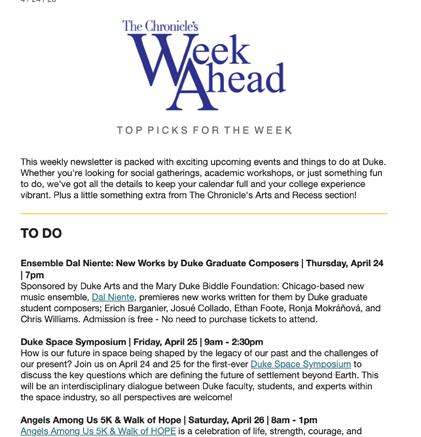

Subscribe to our daily email with The Chronicle’s top headlines.

Get a wrap-up of the week’s Duke sports news — with scores, commentary, analysis.
Editor-in-Chief: Ana Despa
Sports Editor: Abby DiSalvo
Managing Editor: Lucas Lin
News Editor: Claire Cranford
Senior Editors: Ryan Kilgallen, Aseel Ibrahim
Photography Editors: Amy Zhang, Anabel Howery
Opinion Editor: Shambhavi Sinha
Recess Editor: Kadin Purath
Features Editor: Kate Haver
Local/National Strategy Editor: Samanyu Gangappa
Health/Science Editor: Winston Qian
University News Editors: Dylan Halper, Ananya Pinnamaneni
City News Editor: Annie Eilers
Features Managing Editors: Sarah Diaz , Claire Chen
Associate News Editors: Ahilan Eraniyan, Ella Moore, Vikram Sambasivan, Aviv Stabinsky, Mia Taubenblat, and Max Tendler
Data Editor: Zoe Kolenovsky
Editor, Strategic Initiatives: Ishita Vaid
Editors-at-Large: Holly Keegan, Rebecca Fan, Madera Longstreet-Lipson, Michelle Voicu
Audience Engagement Leadership: Ranjan Jindal, Abby Spiller, and Mia Penner
Sports Managing Editors: Martin Heintzelman, Elle Chavis
Enterprise Project Editors: Michael Austin, Ishita Vaid
Recruitment/Social Chair: Michelle Brown
General Manager: Chrissy Murray
Advertising Manager: Megan Haven
Managing Director: Kyle Fox
Creative Manager: Julie Moore
The Chronicle is published by the Duke Student Publishing Company, Inc., a non-profit corporation independent of Duke University. The opinions expressed in this newspaper are not necessarily those of Duke University, its students, faculty, staff, administration or trustees. Columns, letters and cartoons represent the views of the authors.
To reach the editorial or business staff, you can find contact information on dukechronicle.com. To reach the Advertising / Business Office at 1517 Hull Avenue call 919-684-3811. @ 2025 Duke Student Publishing Company

